The Environment
Biodiversity
KPI
Move the screen to the left or right to see the table information
| Item | FY 2021 results | FY 2022 results |
|---|---|---|
| Implementation rate of biodiversity conservation activities for ecosystems near production facilities |
(Consolidated) 50% (13 domestic business locations, and 9 overseas locations) |
(Consolidated) 50% (12 domestic business locations, and 9 overseas locations) |
| Biodiversity in each area, and impact | Yokohama Tire Retread Co., Ltd. (YTRH) Vicinity of Lake Utonai |
Yokohama Tire Retread Co., Ltd. (YTRH) Vicinity of Lake Utonai |
| Habitats being safeguarded or restored | Satoyama (traditional community-managed forest) conservation in Toyooka Village, Nagano Prefecture; Satoyama conservation in Tsuchiya district, Hiratsuka City, Kanagawa Prefecture; conservation of Caretta caretta (Loggerhead turtle) egg-laying sites along the Ominato Coast in Ise City, Mie Prefecture, and conservation of breeding grounds of Sialia sialis (Eastern bluebird) at Virginia Plant | Satoyama (traditional community-managed forest) conservation in Toyooka Village, Nagano Prefecture; Satoyama conservation in Tsuchiya district, Hiratsuka City, Kanagawa Prefecture; conservation of Caretta caretta (Loggerhead turtle) egg-laying sites along the Ominato Coast in Ise City, Mie Prefecture, and conservation of breeding grounds of Sialia sialis (Eastern bluebird) at Virginia Plant |
|
Total number of species included in the IUCN Red List of Threatened Species or in Japan’s domestic list of species requiring special conservation efforts <Categories of threatened species> ・Critically endangered (CR) ・Endangered (EN) ・Vulnerable (VU) ・Non-threatened (NT) ・Least concern |
Rivers receiving wastewater CR+EN: One species: Anguilla japonica (Japanese eel) (Kaname River, Hinokijiri River) VU: Two species: Oryzias latipes (Japanese rice fish) (each river) and Liobagrus reinii (Torrent catfish) (Tenryu River) NT: Five species: Veronica undulata (Kaname River), Diplonychus japonicus (Ferocious water bug) (Sonobe River), Cottus pollux (Japanese fluvial sculpins) (Kuroda River), Pelophylax nigromaculatus (Black-spotted Pond Frog) (Tenryu River), Mauremys japonica (Japanese pond turtle) (Goten River) On premises of plants and satoyama VU: One species: Cephalanthera falcata NT: Four species: Sasakia charonda (Great purple emperor), Psilotum nudum (Whisk fern), Calanthe discolor, Cynops pyrrhogaster (Japanese fire belly newt) Least concern: One species: Vanellus cinereus (Grey-headed lapwing) Beaches near to where wastewater flows out EN: One species: Caretta caretta (Loggerhead turtle) (Ominato coast) |
Rivers receiving wastewater CR+EN: One species: Anguilla japonica (Japanese eel) (Kaname River, Hinokijiri River) VU: One species: Oryzias latipes (Japanese rice fish) (each river) NT: Five species: Veronica undulata (Kaname River), Diplonychus japonicus (Ferocious water bug) (Sonobe River), Cottus pollux (Japanese fluvial sculpins) (Kuroda River), Pelophylax nigromaculatus (Black-spotted Pond Frog) (Tenryu River), Mauremys japonica (Japanese pond turtle) (Goten River) On premises of plants and satoyama VU: Two species: Cephalanthera falcate and Butastur indicus NT: Four species: Sasakia charonda (Great purple emperor), Psilotum nudum (Whisk fern), Calanthe discolor, Cynops pyrrhogaster (Japanese fire belly newt) Least concern: One species: Vanellus cinereus (Grey-headed lapwing) Beaches near to where wastewater flows out EN: One species: Caretta caretta (Loggerhead turtle) (Ominato coast) |
Responsible Departments
- Activities are conducted by each office, with the Biodiversity Committee (which the Environmental Protection Promotion Department serves as a secretariat for) implementing company-wide policy discussions and activities.
Our position and Targets
Why is “Biodiversity” a critical issue to be addressed?
Explanation of the reason and background
To address these issues, Yokohama Rubber Group established its Biodiversity Guideline in 2010, and has been working on the conservation of biodiversity through its value chain locations. For years, we have been running the Yokohama Forever Forest Program to plant trees and to provide saplings in areas around our production sites. We also perform various biodiversity conservation activities to ensure that the plants and animals living in our production site premises has positive effect on the surrounding regional ecosystem. In January 2023, we joined the "30by30 Alliance for Biodiversity," a coalition of companies and other organizations directing all-Japan efforts to achieve "30by30," an international goal of conserving and protecting more than 30% of land and sea by 2030 toward the goal of nature positive. In the same month, we endorsed the philosophy of the Task Force on Nature-related Financial Disclosures (hereinafter referred to as TNFD) and participated in the "TNFD Forum," an international stakeholder organization that supports the establishment of a framework for the disclosure of nature-related financial information, as well as in "Keidanren Initiative for Biodiversity Conservation."
In December 2023, the Biodiversity Guideline was revised to reflect national and international trends.
Yokohama Rubber Group Biodiversity Guideline
<Basic Policy>
<Action Guidelines>
- Recognize the issue of biodiversity as a business challenge and continually monitor the sustainable use of natural resources and biodiversity conservation.
Yokohama Rubber Group recognizes the issue of biodiversity as a business challenge and promotes sustainable use of natural resources and biodiversity conservation. Furthermore, we regularly assess risks and opportunities related to nature and build a system in which management monitors them. - Understand the relationship between business and impacts on biodiversity and its dependency on nature by scientific approaches.
We strive to understand the relationship between our business and impacts on biodiversity and its dependency on nature in relevant locations throughout the entire value chain from the procurement of raw materials to disposal of products by scientific approaches. We identify business activities that greatly impact biodiversity, set goals, and conduct continuous monitoring. - Reduce negative impacts caused by our business activities, while increasing positive impacts.
We strive to avoid/reduce negative impacts on biodiversity caused by our business activities such as land use, resources use including natural rubber and water, climate change, pollution, and alien species accompanied by our business activities, and restore/regenerate nature to increase positive impacts, thereby contributing to biodiversity conservation. - Promote the sustainable use of natural resources throughout the entire value chain through technological innovation.
In addition to the negative impacts in the production phase such as use of resources, we also aim to suppress negative impacts caused downstream of the value chain including the disposal phase, and promote innovative technological development to promote sustainable use of resources. - Have the integrated perspective to solve social issues including biodiversity and climate change.
We promote solutions that are effective for eliminating the trade-off relationship of biodiversity and climate change and increasing the effects of activities at the same time. We also act from an integrated perspective to solve social issues such as human rights, labor issue, and poverty. We give particular consideration to the rights of indigenous peoples and local communities, and to gender equity. - Promote biodiversity conservation in collaboration with suppliers to increase sustainability of natural resources.
Our business uses various natural resources such as natural rubber and water. We strive to promote conservation of such resources and ensure traceability in collaboration with suppliers including farmers to increase the sustainability of natural resources throughout the supply chain. - Support employees so they can contribute to biodiversity conservation.
We support employees in biodiversity conservation in the course of their work as well as in local communities through raising their awareness of biodiversity and behavior change leading to practice. - Build a trust relationship through communication and collaboration with stakeholders to increase the effectiveness of initiatives.
We build a trust relationship with various stakeholders such as national agencies and municipalities, non-governmental organizations (NGOs), research/educational institutes, and local communities and strive to improve initiatives and enhance capabilities to increase the effectiveness of our initiatives. - Actively disclose information on a regular basis about efforts for biodiversity conservation in accordance with these policies.
We actively disclose information about our efforts related to biodiversity in accordance with these policies by making use of various opportunities on a regular basis to gain understanding of internal and external stakeholders to promote sustainable management.
Vision and targets
Short-term and medium-term goals
| Item | Targets | Achieved year | Progress in FY2022 |
|---|---|---|---|
| Number of natural rubber plantations surveyed | Cumulative total of 500 | FY2023 | Total 437 units (Cumulative total of 500 units achieved in February 2023) |
| Percentage of natural rubber suppliers surveyed(Tier1) | 100% | FY2023 | 85% (relative to supply) |
| Implemented grievance mechanisms | Completed | FY2023 | Completed |
| Item | Targets | Achieved year | Progress in FY2022 |
|---|---|---|---|
| Number of saplings provided to natural rubber plantations for agroforestry | Cumulative total of 130,000 trees | FY2030 | Cumulative total of 53,000 trees |
| Number of farmers introducing agroforestry | Cumulative total of 170 | FY2030 | Cumulative total of 63 units |
- Agroforestry is a term created from the words agriculture and forestry, and refers to the grazing of livestock and cultivation of crops between planting trees. Yokohama Rubber is promoting agroforestry in natural rubber plantations.
| Item | Targets | Achieved year | Progress in FY2022 |
|---|---|---|---|
| Number of trees planted and saplings provided | Cumulative total of 1.3 million trees | FY2030 | Cumulative total of 1.2 Million trees |
Yokohama Rubber is committed to the realization of a society that coexists in harmony with nature through its business activities.
In the preservation of biodiversity, we evaluate the impact that our business activities have on the natural environment and upon ecosystems, and then implement conservation activities in order that this impact can be further mitigated. Additionally, we aim for harmony with nature and the development of employees with an awareness of the environment.
YOKOHAMA Forever Forest project achieved its goal to plant 500,000 seedlings in both our domestic and overseas production sites and related department sites in September 2017. Going forward, the project is working toward the new target of planting 1.3 million trees by 2030 through afforestation at production sites and related department sites and the provision of seedlings to communities.
<Overview of Yokohama Rubber’s Activities to Conserve Biological Diversity>
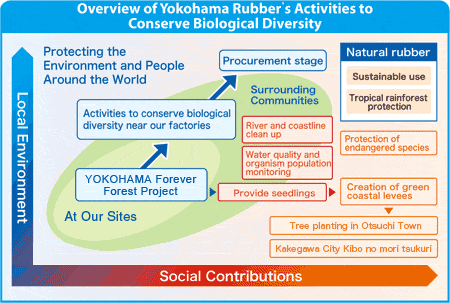
Measures for vision achievement
In the raw material procurement stage, natural rubber procurement is considered to have the highest biodiversity impact, while in the production stage, land use and water intake and discharge by our production sites have the highest biodiversity impact. Our production sites are located in widely varying conditions in terms of geography, history, and culture. Since ecosystems surrounding these sites also differ, we believe it is necessary to accurately understand the biodiversity situation surrounding each site and we deploy our biodiversity activities in stages. After gaining a general picture of the site location, including what bodies of water and vegetation exist in the area, whether any nature reserves are nearby and whether it is close to residential areas and other factories, we conduct surveys on the water quality of rivers that could be possibly affected by our production activities, and monitor living organisms that are found in the areas surrounding the production site. In particular, we select a number of specific living creatures for continual monitoring targets. Through continuing such monitoring throughout the year, we assess the impact of our business activities, determine which organisms require conservation practice and conduct such conservation activities, and disclose the findings.
As part of water quality surveys, we measure the water temperature, electrical conductivity, pH, etc. For the monitoring of living organisms, we conduct bird-watching, vegetation survey, insect and also observe aquatic organisms.
Move the screen to the left or right to see the table information
| Business location | Location | Water quality* | Aquatic life | Vegetation | Wild birds | Insect | Other | |
|---|---|---|---|---|---|---|---|---|
| In Japan | Mie Plant | Within premises | ○ | ○ | ○ | ○ | ○ | |
| Outside premises | ○ | ○ | ○ | ○ | ○ | Loggerhead turtle | ||
| Mishima Plant | Outside premises | ○ | ○ | ○ | ||||
| Shinshiro Plant | Within premises | ○ | ○ | ○ | Increasing Semisulcospira libertina | |||
| Outside premises | ○ | ○ | Amphibians | |||||
| Onomichi Plant | Within premises | ○ | ○ | ○ | ||||
| Outside premises | ○ | ○ | ○ | ○ | ||||
| Hiratsuka Factory | Within premises | ○ | ○ | ○ | ○ | ○ | ||
| Outside premises | ○ | ○ | ○ | ○ | ○ | |||
| Ibaraki Plant | Within premises | ○ | ○ | ○ | ○ | Creating an environment for Grey-faced buzzard (Amphibians, Reptiles) |
||
| Outside premises | ○ | ○ | ○ | ○ | ||||
| Nagano Plant | Outside premises | ○ | ○ | ○ | ○ | |||
| Yokohama Tire Retread Hokkaido Plant | Outside premises | ○ | ○ | ○ | ○ | ○ | ||
| Yokohama Tire Retread Nagoya Plant | Outside premises | ○ | ○ | ○ | ○ | ○ | Biotope | |
| Yokohama Tire Retread Onomichi Plant | Outside premises | ○ | ○ | ○ | ○ | ○ | ||
| Yokohama Mold | Outside premises | ○ | ○ | ○ | ○ | |||
| Overseas | YTMT (Thailand) | Within premises | ○ | ○ | ○ | |||
| YTRC (Thailand) | Within premises | ○ | ○ | ○ | ||||
| Y-CH (China) | Outside premises | Laojunshan Project | ||||||
| CHZY (China) | Within premises | ○ | ○ | ○ | ||||
| Outside premises | ○ | ○ | ○ | ○ | ○ | |||
| CSZY (China) | Within premises | ○ | ○ | ○ | ||||
| YTPI (Philippines) | Within premises | ○ | ○ | ○ | ||||
| Outside premises | ○ | ○ | ○ | Watershed conservation | ||||
| YTMV (United States) | Within premises | ○ | ○ | Mammals | ||||
| YTVI (Vietnam) | Outside premises | ○ |
- Presence or absence of biodiversity activities

Yokohama Forever Forest Program
In wild bird surveys at the Hiratsuka Factory, 61 species of wild birds have been observed on the plant premises to date. From In the third year of our tree planting initiative, we began to see Turdus chrysolaus (red-bellied thrushes) that have a preference for forests. We believe this reflects how the Forever Forest is functioning as it should as a forest for wild birds. We also observed Phylloscopus coronatus (eastern crowned warblers) and Acrocephalus orientalis (oriental great reed warblers), which are normally seen near bodies of water) were observed, which seems to show that our Forever Forest is serving also as a stopping point for migrating wild birds during their travel. Furthermore, it has been observed that the forest is used by Zosterops japonicus (warbling white-eyes) and other various wild birds to build nests and raise their children, suggesting that the forest contributes to the breeding of wild birds as well.
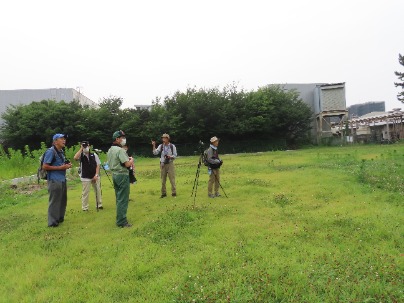
Review of FY 2022 Activities
Various initiatives underway to make natural rubber a sustainable resource
In January 2020, Yokohama rubber signed a Memorandum of Understanding (MOU) with the Rubber Authority of Thailand (RAOT) to collaboratively support the management of natural rubber farmers and improve traceability in order to ensure the transparency and soundness of the supply chain.
Under the MOU, seminar events for natural rubber farmers have been held since December 2020. To date, five such events have been held, attended by a total of 250 farmers, and a total of 75 tons of fertilizer utilizing RAOT's findings has been provided free of charge.
Communication with communities
Employee education
Introduction of Initiatives
Hiratsuka Factory
Currently, we are continuing activities in a satoyama area in a city located upstream of the Kaname River. Specifically, we have been engaged in conservation activities, including the installation of handmade biotopes in croplands in valleys and the regeneration of abandoned cedar forests in valleys since 2015 with the aim of water source cultivation of the Kaname River and restoring the original landscape of the satoyama. We have also started to collaborate with people from the local university to conduct a survey on changes in the brightness level caused by the thinning of ceder trees. We zoned the area in the valleys with this environment into several plots, and decided on target species, the content of activities, and the target image, so that we can understand the effects and goals of the activities. Due to the COVID-19 pandemic and a number of other reasons, we suspended the activity during FY2022.
Responding to a call from the Kaname River Basin System Network, we have engaged in river cleaning with the local government and groups in March every year. Due to the COVID-19 pandemic and a number of other reasons, we suspended the activity during FY2022.
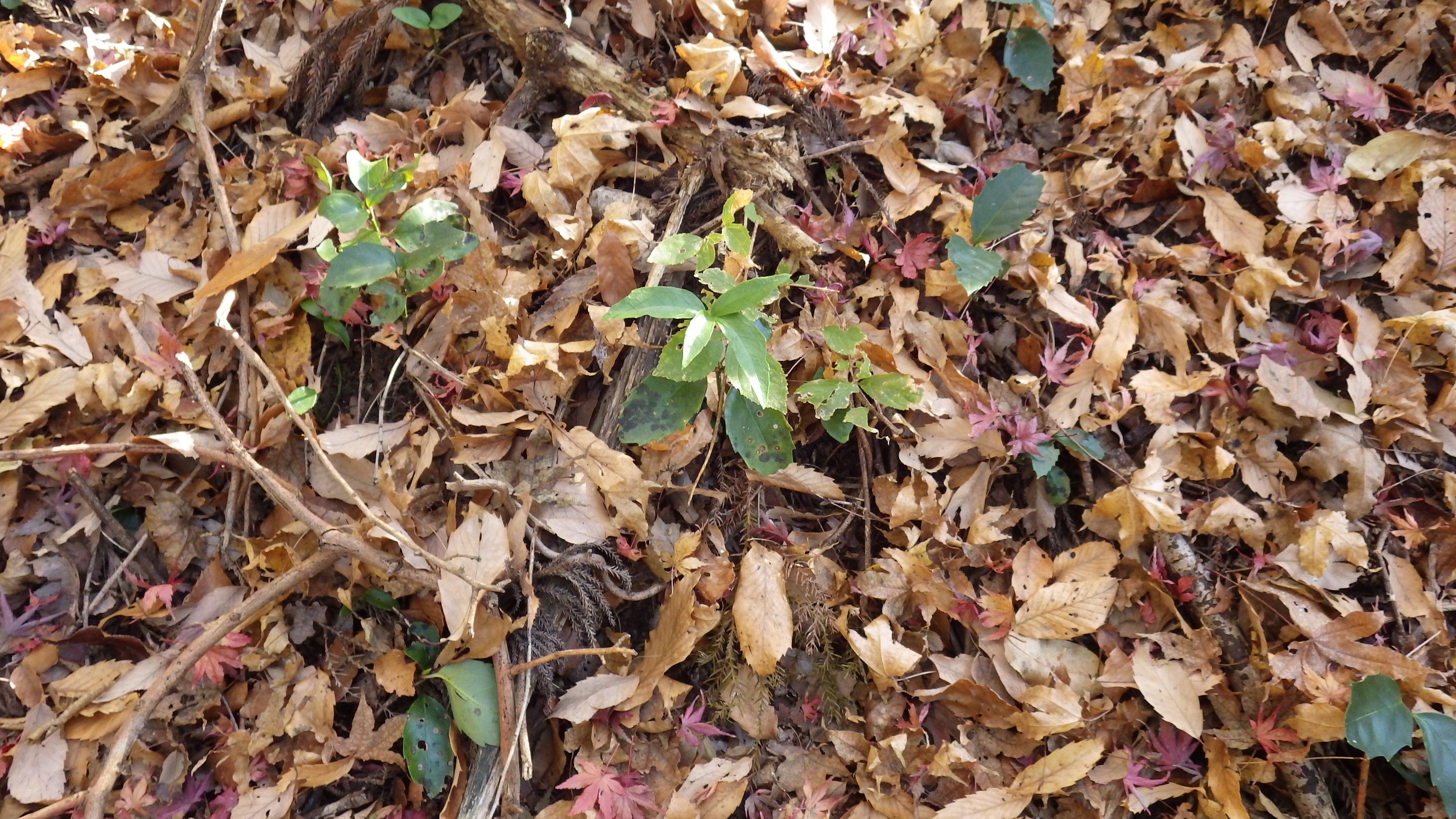
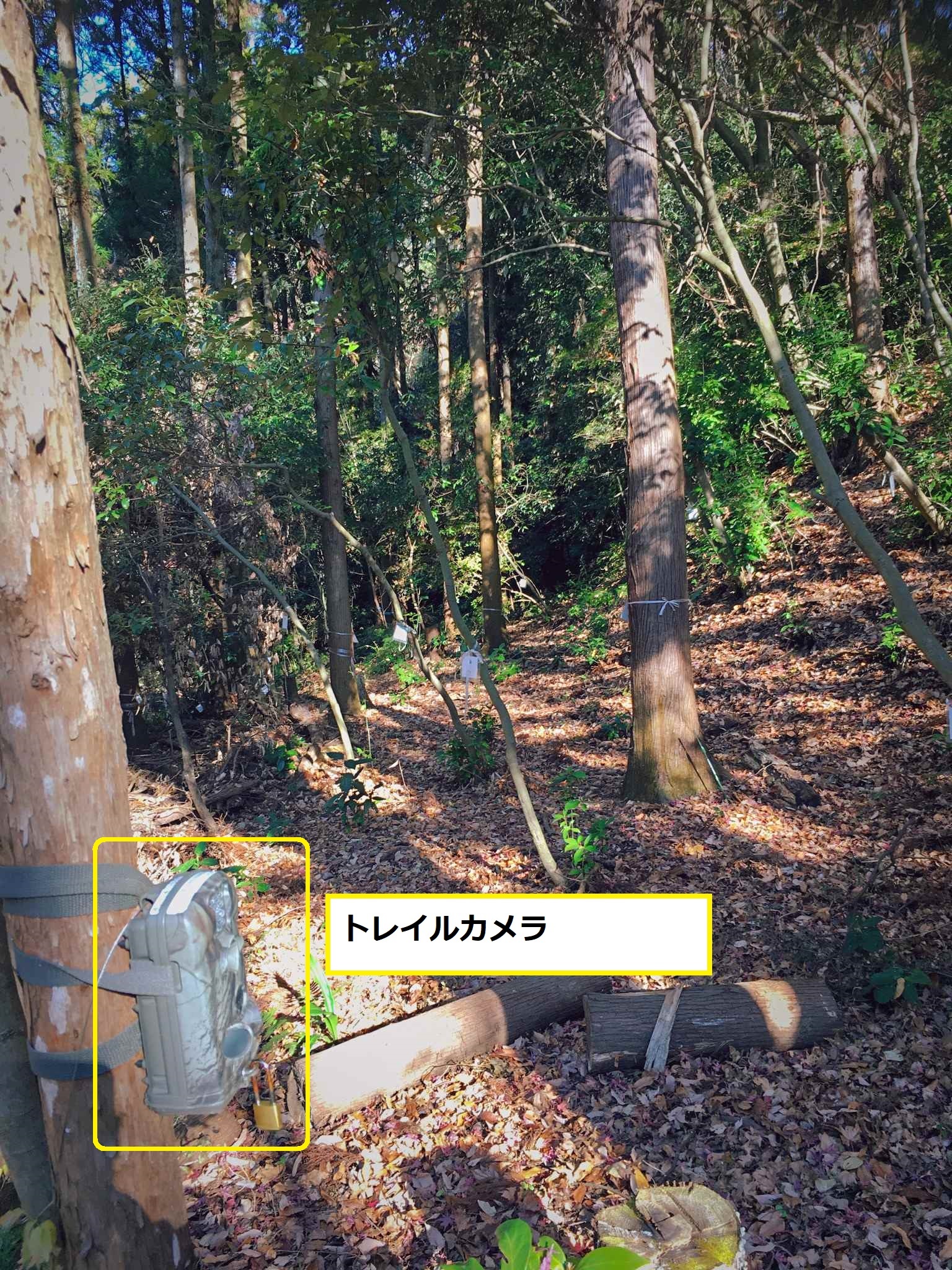
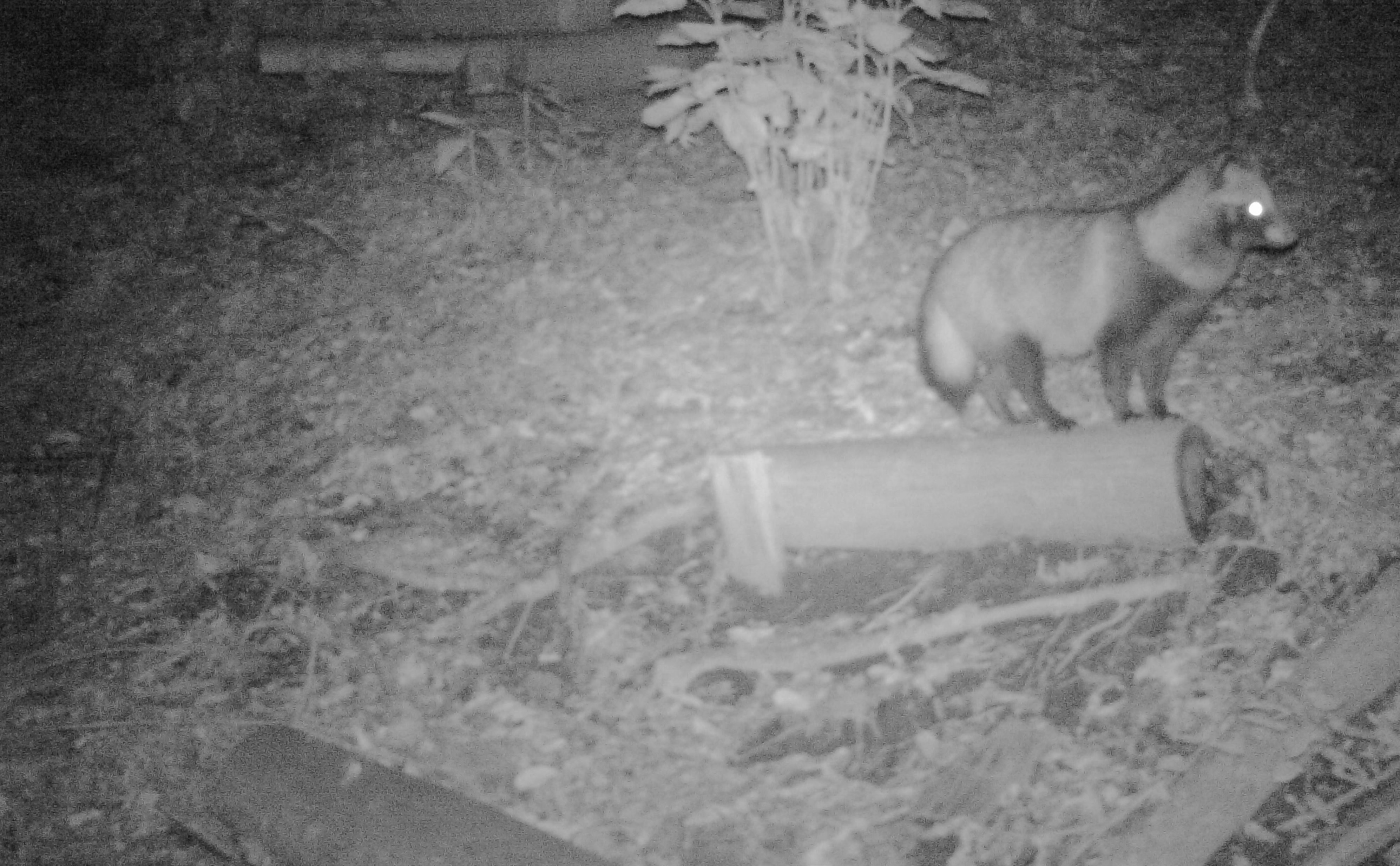
In March 2017, the Hiratsuka Factory obtained the "Association for Business Innovation in Harmony with Nature and Community® (ABINC) certification" as a factory showing consideration for biodiversity. The factory was acknowledged for their activities to conserve biological diversity and ongoing surveys on the amount of CO2 absorbed and fixed by the growing trees of the Forever Forest planted in and around the business site in 2007. The factory still keeps having the certification updated.
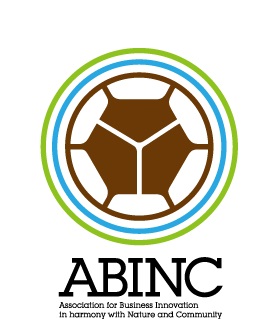
In addition, we display panels at "Sagami Nature Forum" hosted by the Nature Conservation Society of Kanagawa in February every year. At the "Hiratsuka Environmental Fair" hosted by Hiratsuka City every July, we show images from our biodiversity activities around the Hiratsuka Factory.
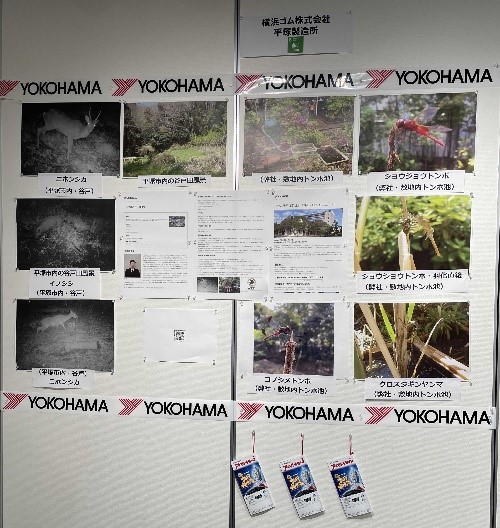
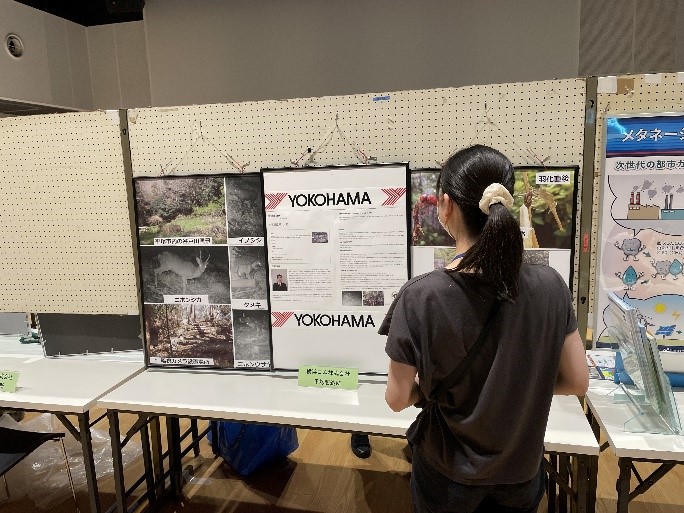
Mie Plant
- Black Team: Conducting surveys on water quality and aquatic organisms such as Oryzias latipes (Japanese ricefish) in the rivers (Hinokijiri River and Hotosu River) into which drainage water is discharged from the plant
- Noppo Team: Removing invasive alien species and measuring the number of native plants, and conducting surveys on Caretta caretta (loggerhead sea turtles) laying eggs on the coast (Ominato Coast) to which the water of the rivers flow down
- Chibikko Team: Creating a biotope in and around the plant's rainwater regulation pond, conducting surveys on water quality, and living creatures such as dragonflies, and aquatic organisms
Due to the COVID-19 pandemic, we could not organize tree-planting and biodiversity conservation activities that we have been implementing every year; however, we restarted to provide environmental educational programs by inviting elementary students to the factory in 2023.
In March 2022, our Mie Plant obtained the "Association for Business Innovation in Harmony with Nature and Community® certification (ABINC certification)" as a factory showing consideration for biodiversity.
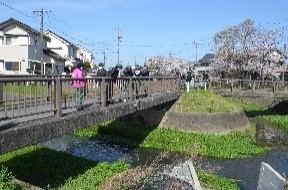
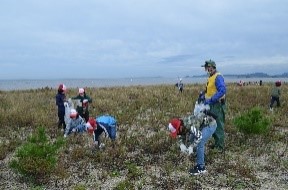
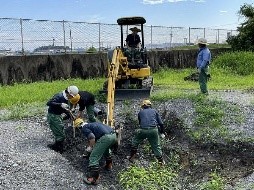
Mishima Plant
The Goten River serves as a nesting place for insects such as dragonfly larvae of Macromia amphigena (koyama dragonflies) and Calopteryx atrata (haguro dragonflies), fish such as Opsariichthys platypus (freshwater minnows), Nipponocypris temminckii (dark chubs) and Amur catfish, and reptiles such as Pelodiscuc sinensis (soft-shell turtles) and Trachemys scripta elegans (red-eared turtles). As a rare case for a factory surrounded by residential buildings, the Mishima factory serves as a nesting place for Alcedo atthis (common kingfishers), the symbol bird of Mishima City. However, since we found a lot of garbage dumped into the river, we have been cleaning the river after monitoring in order to contribute even in small ways to keeping the Goten River clean and beautiful. In May 2019, the Numazu Civil Engineering Office of Shizuoka Prefecture, the Mishima city government and our Mishima Plant signed a "River Friendship Agreement," and since then, we have been collaboratively engaged in river improvement work with people from the Numazu Civil Engineering Office using the "stream barbs construction method." As a result of the continuous activities, we were able to confirm that creatures that had almost disappeared after river dredging began to return again.
We also found Ranunculus nipponicus var. japonicus (Japanese water-crowfoots) and Psilotum nudum (whisk ferns), which are on Shizuoka Prefecture's Red List of Vulnerable Creatures and were not used to be seen in the downstream side from the plant in the Goten River. In the future, we would like to invite local residents to join these activities. Dealing with an increase in natural disasters and heavy rainfalls, we have been continuing the activities to the extent possible.
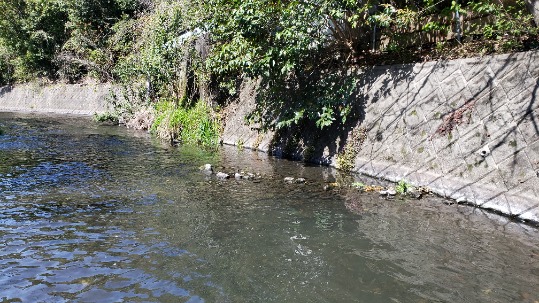
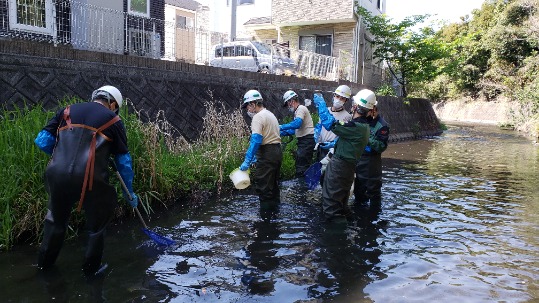
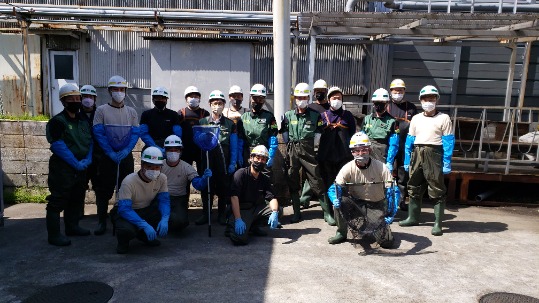
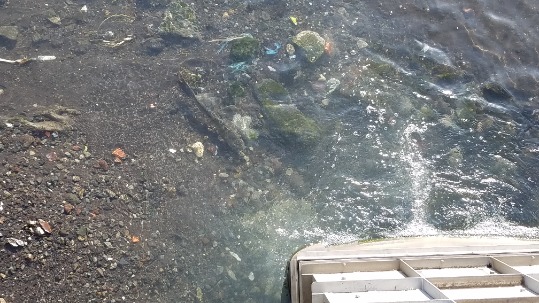
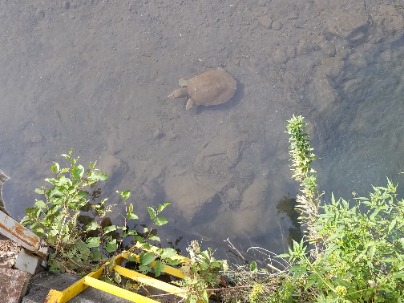
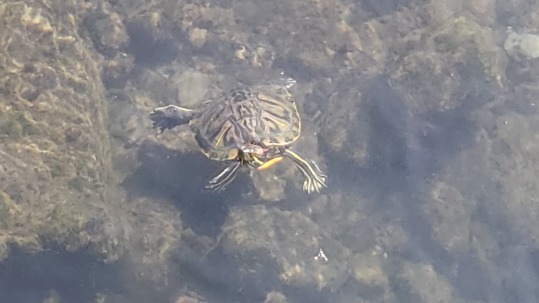
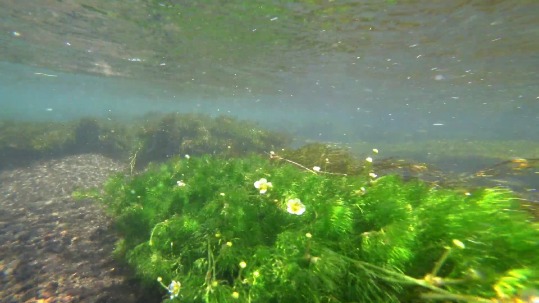
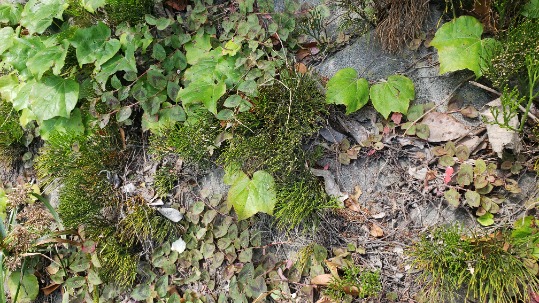
Shinshiro Plant
As the impact from the COVID-19 pandemic finally subsided, we gradually increased the number of participants, and started the Nodagawa Firefly Project, a new activity to conduct in collaboration with local people, in addition to regular activities, such as surveys on water quality and monitoring of creatures.
In addition to creating a waterside biotope and integrally developing a woodland and grassy areas within the plant premises, we have worked on the creation of a "Forever Forest" and engaged in monitoring activities in collaboration with local people, neighboring companies and groups. In February 2022, the Shinshiro Plant, in recognition of these efforts, obtained the Association for Business Innovation in Harmony with Nature and Community® certification (ABINC certification). In November of the same year, the Shinshiro Plant also obtained the blue-chip company certification of the "Aichi Biodiversity Company Certification Program", which was established by Aichi Prefecture to certify companies making excellent efforts for the conservation of biodiversity.
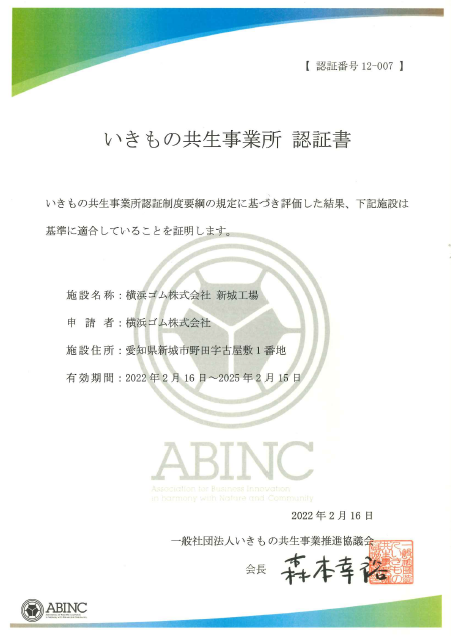
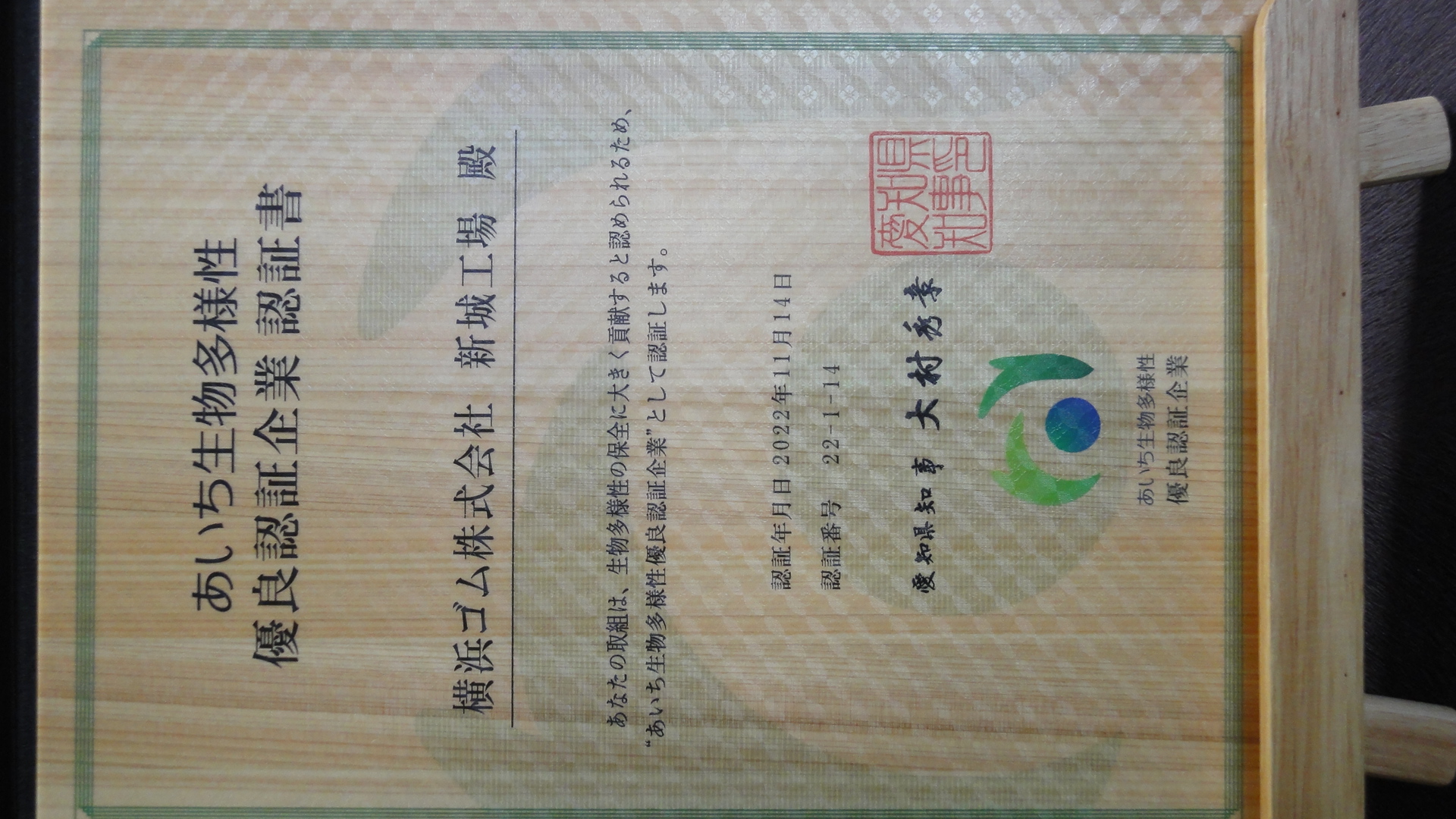
This area has been served a water source for the industrial cooling water. We worked to secure a habitat for biological communities, help maintain clear streams and near threatened species, protect and restore water-related ecosystems, and support a desirable ecological habitat in the senmaida.
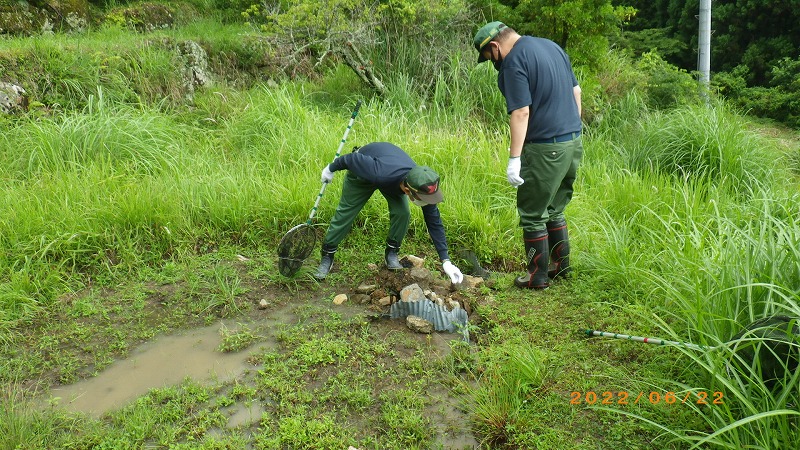
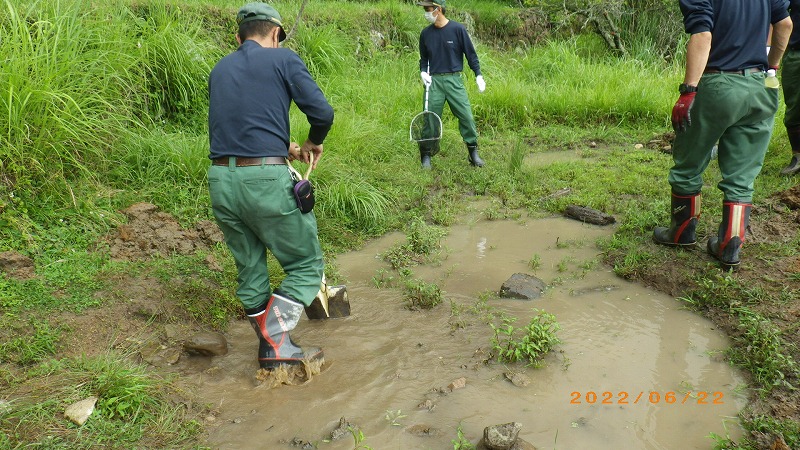
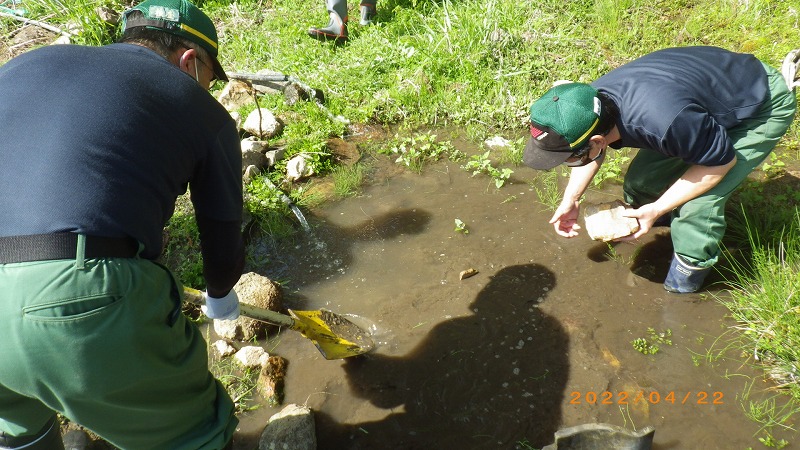
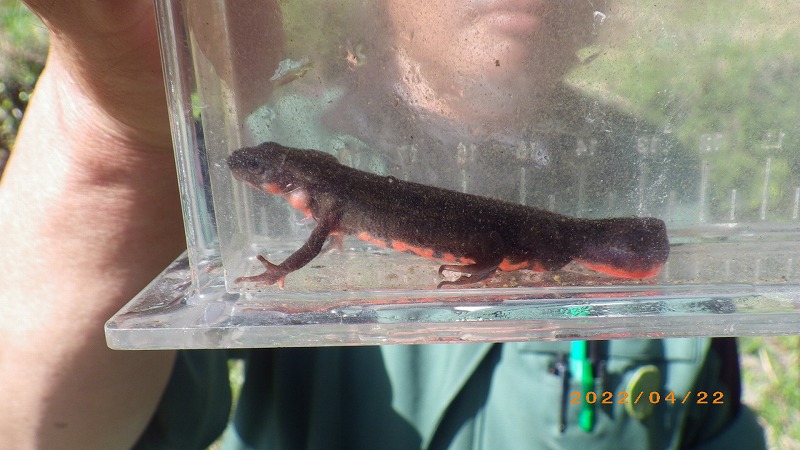
We confirmed that drainage water discharged from the Shinshiro Plant and Shinshiro-Minami Plant does not adversely affect water quality and aquatic life in the local rivers, and carried out activities to maintain and sustain this status.
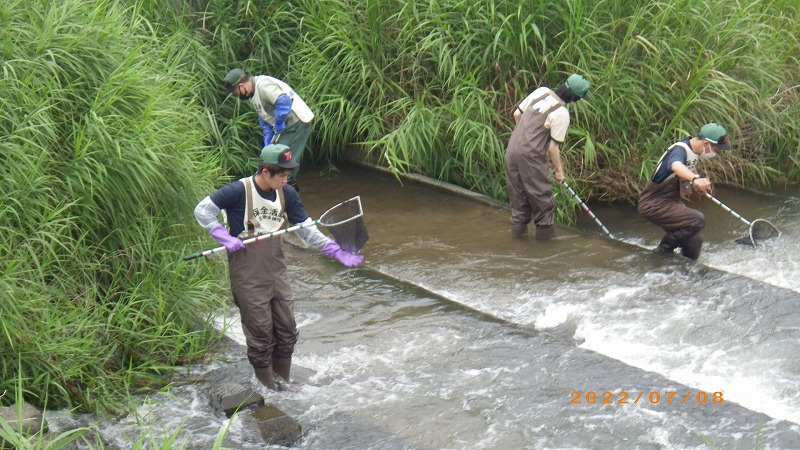
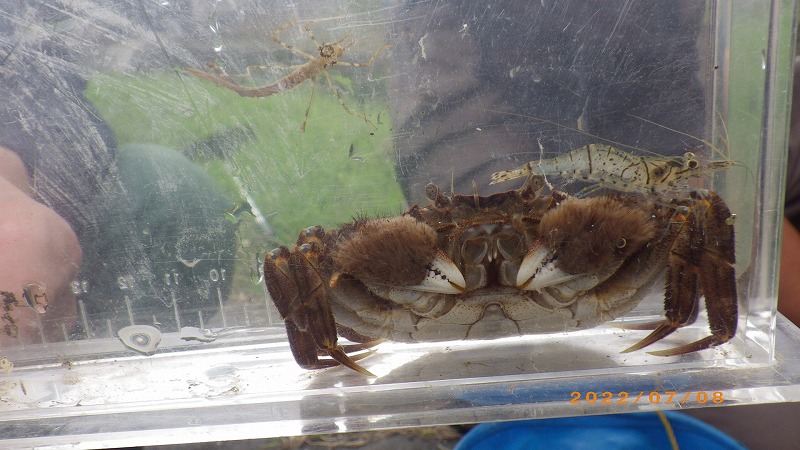
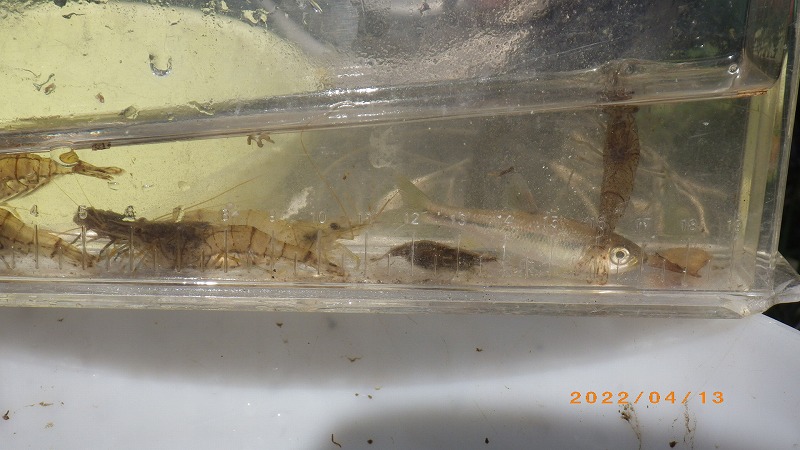
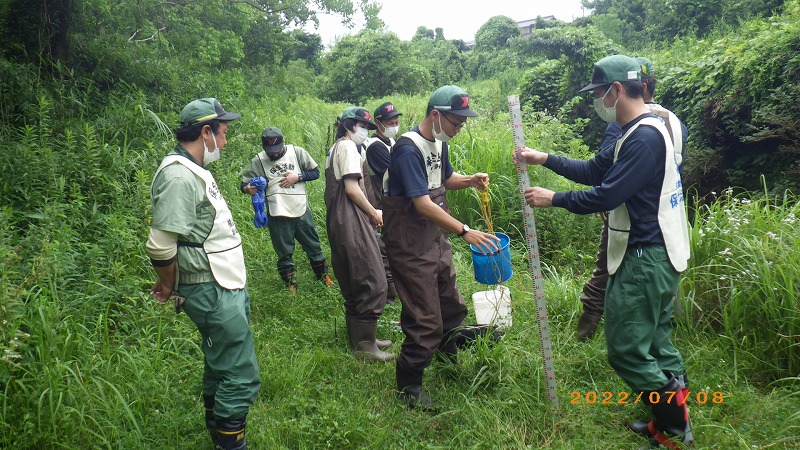
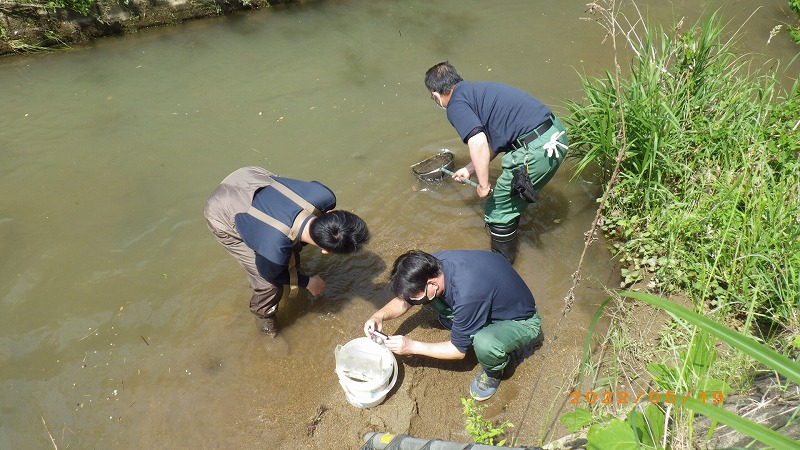
The Shinshiro Plant takes cooling water used in the plant from the nearby Noda River and discharge used water into the Noda River. Since 2010, we have been observing living creatures at the biotope in order to demonstrate that it is possible to create an environment where living creatures can live even with plant effluent by introducing effluent water to the biotope inside the plant. We also conduct maintenance and restoration work around the biotope every year.
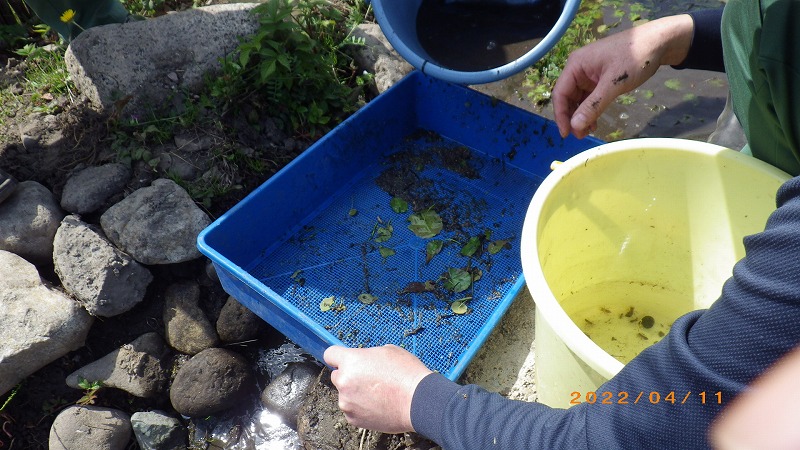
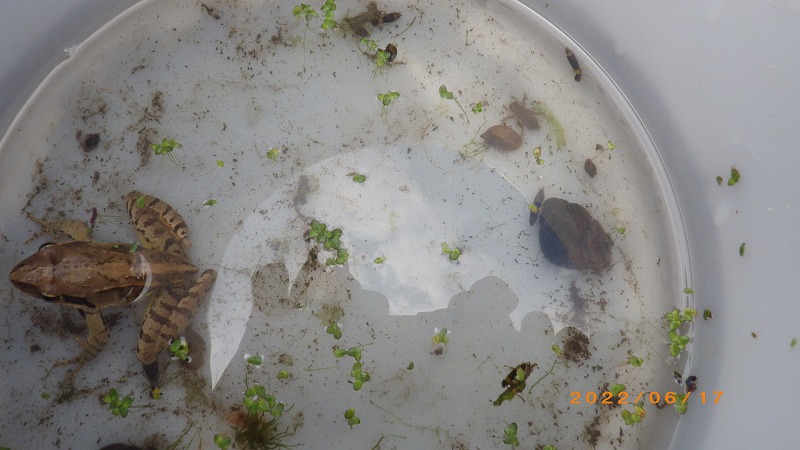
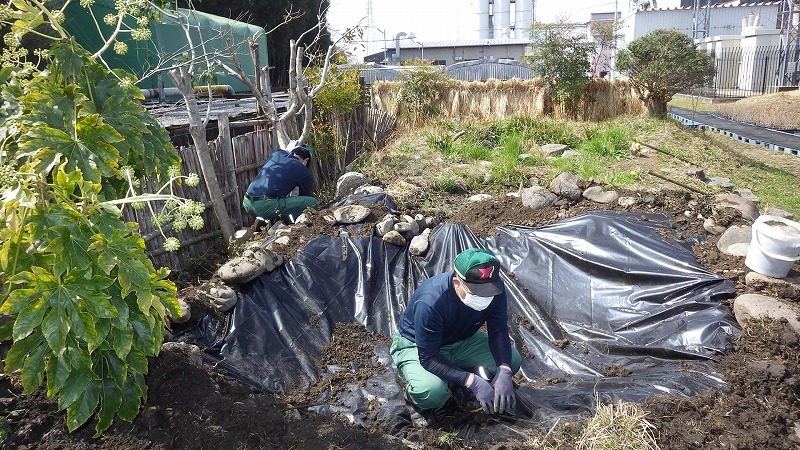
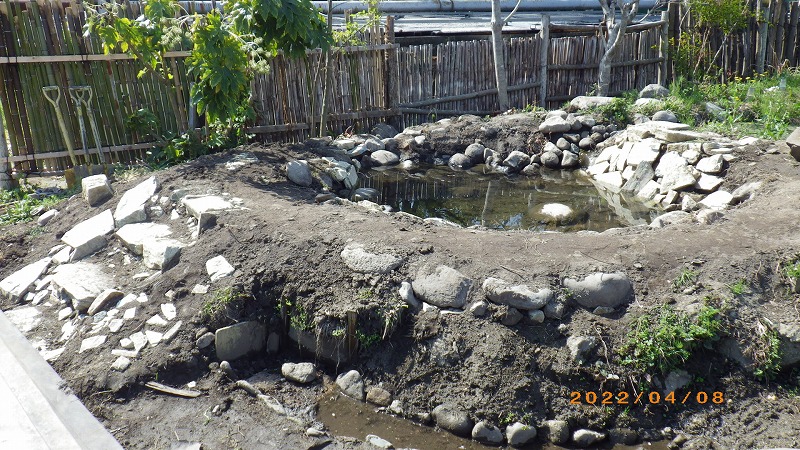
Responding to residents in the neighborhood saying there used to be a lot of fireflies in the past, we launched a five-year plan called "Nodagawa Firefly Project" aiming at the returning of fireflies as one of the pillars for the environmental conservation of the Noda River used by the plant for water intake and water discharge.
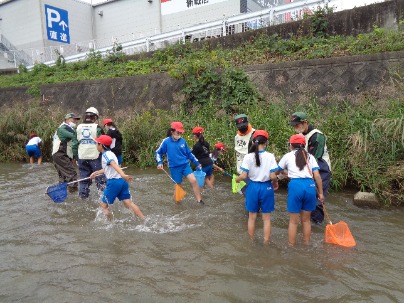
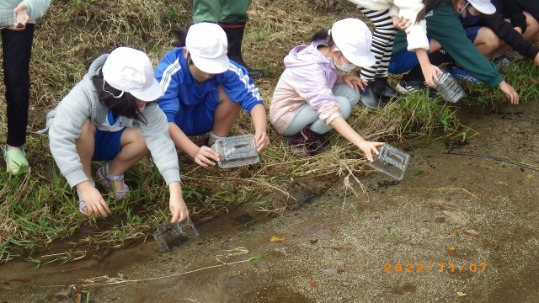
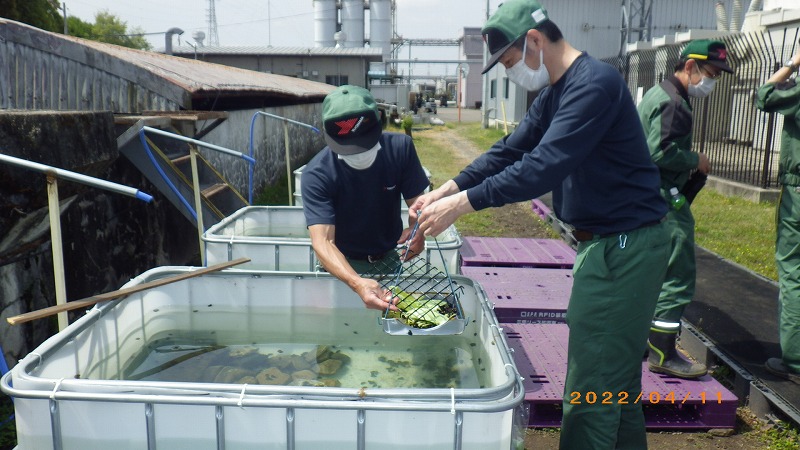
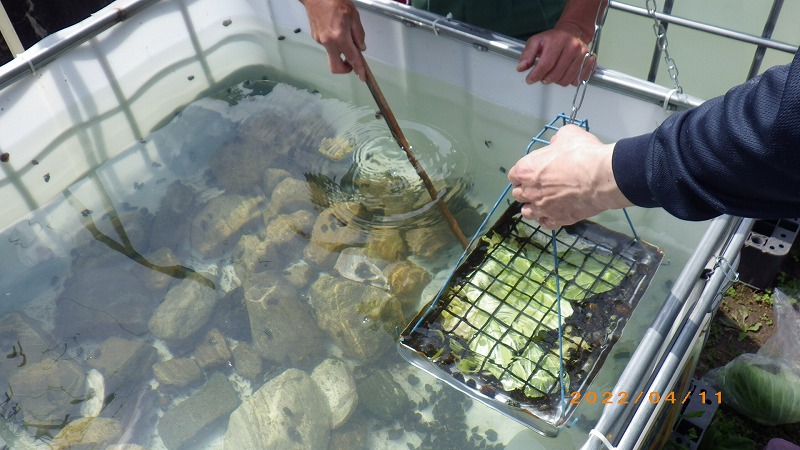
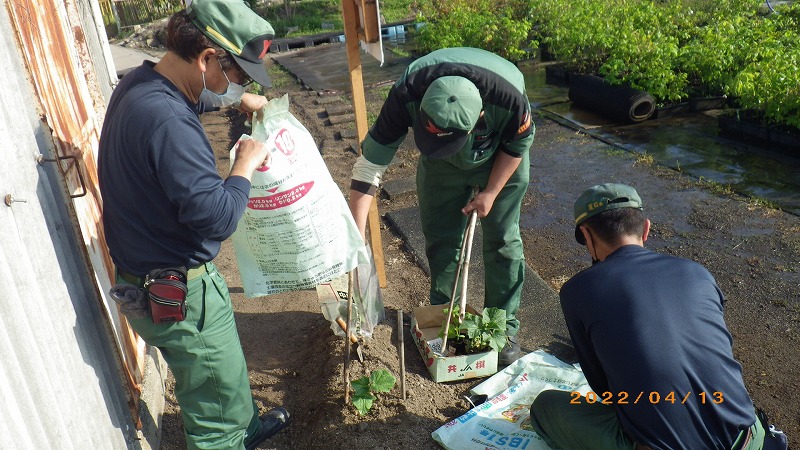
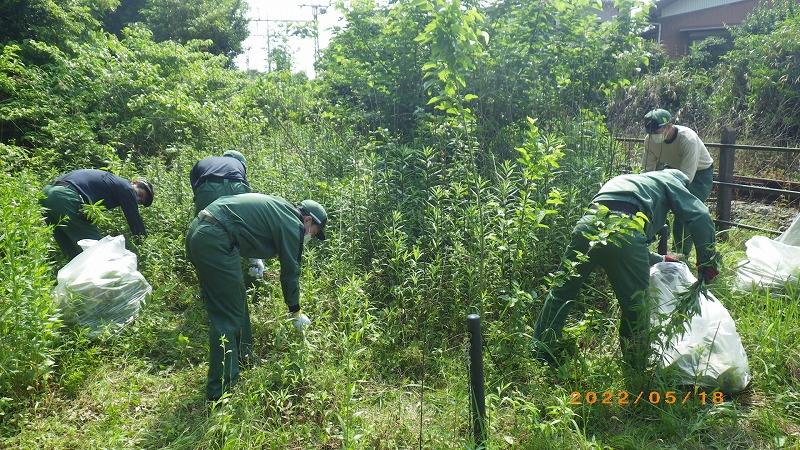
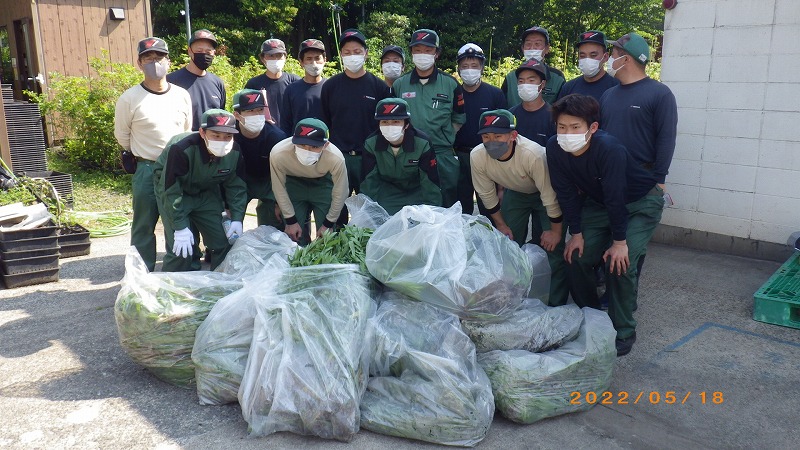
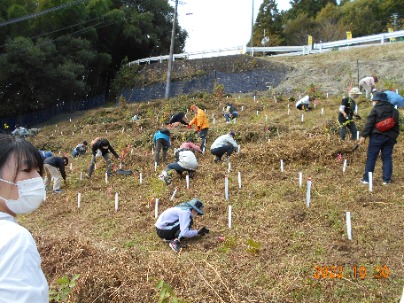
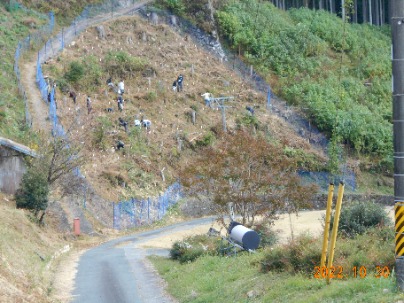
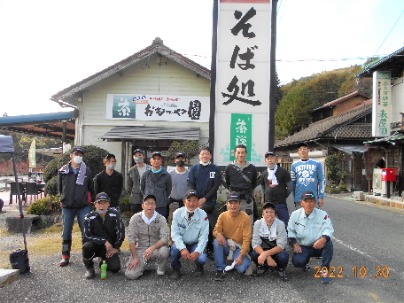
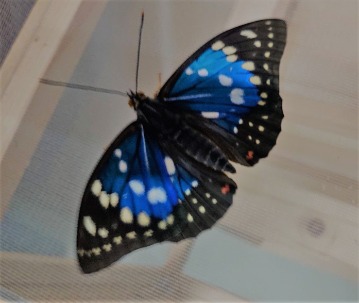
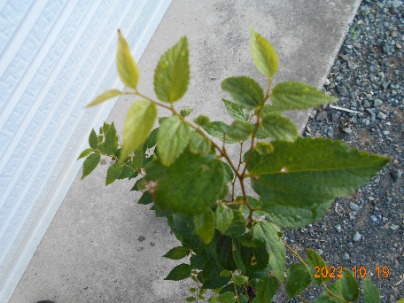
Onomichi Plant
In the surveys of aquatic life in the Fujii River, we found aquatic insects such as Ephemera strigata (a species of green drakes), Mnais costalis (broad-winged damselflies) and Asiagomphus melaenops (yamasanae dragonflies), and fish such as Gnathopogon elongatus (tamoroko), Odontobutis obscura (dark sleepers) and Rhinogobius nagoyae, and crustaceans such as Eriocheir japonicus (Japanese mitten crabs) and Palaemon paucidens (lake prawns); however, due to the COVID-19 pandemic, we conducted only bird-watching and river-cleanup activities in 2022.
Within the plant premises, the Forever Forest grove formation, along with bushes, grasslands, rain-fed ponds and wetlands led to providing a variety of environments for living creatures, constituting an inhabiting environment for dragonflies, butterflies, crickets and grasshoppers. It was also found that the factory site contributes to the nesting of Alauda arvensis (skylarks), the formation of territories of Lanius bucephalus (bull-headed shrikes) and Phoenicurus auroreus (Daurian redstart), and the wintering of Horornis diphone (Japanese bush warblers). We conduct these activities three times a year in collaboration with our consultants and people from the Wild Bird Society of Japan Hiroshima Branch.
The "Fujii River Evening," which was to be held in June 2022, was canceled due to the COVID-19 pandemic; however, at the Children's Environmental Festival held in August 2022 at the Onomichi City Environmental Resource and Recycling Center, we exhibited panels showing our conservation activities at the Fujii River, fixed-point observation, and other biodiversity activities by Onomichi Plant employees. In addition, in June 2023, we held the "Fujii River Evening" for the first time in four years, we exhibited materials about our conservation efforts and fixed-point observation, and offered saplings for free.
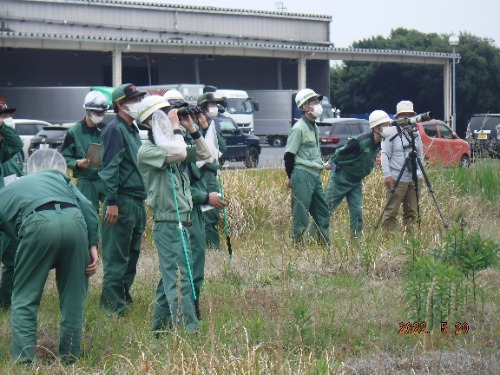
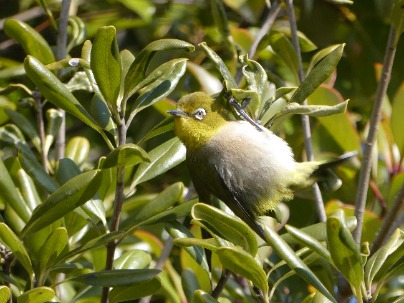
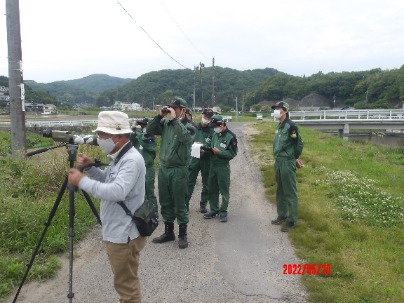
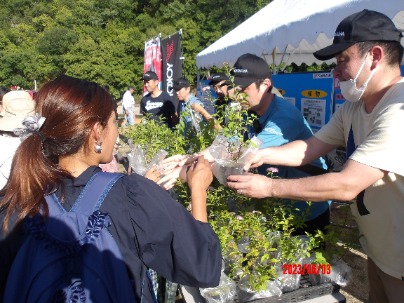
Nagano Plant
Since the Nagano Plant is located on a river terrace of the Tenryu River, we started biodiversity conservation activities in the plant's rainwater regulation pond in 2021 with the aim of restoring the back-marsh ecosystem of the Tenryu River within the plant premises. To this end, we have decided to exterminate invasive Solidago altissima (tall goldenrods) and Solanum carolinense (Carolina horsenettle) found in the monitoring activities, and each section is in charge of carrying out this activity every year from June to September.
We also conduct monitoring of living creatures, exterminate invasive alien species, and carry out cleanup activities at the irrigation canal on the south side of the plant where rainwater is discharged.
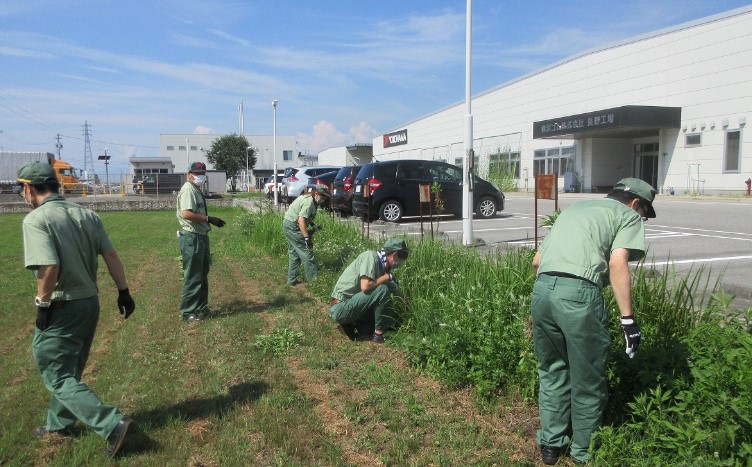
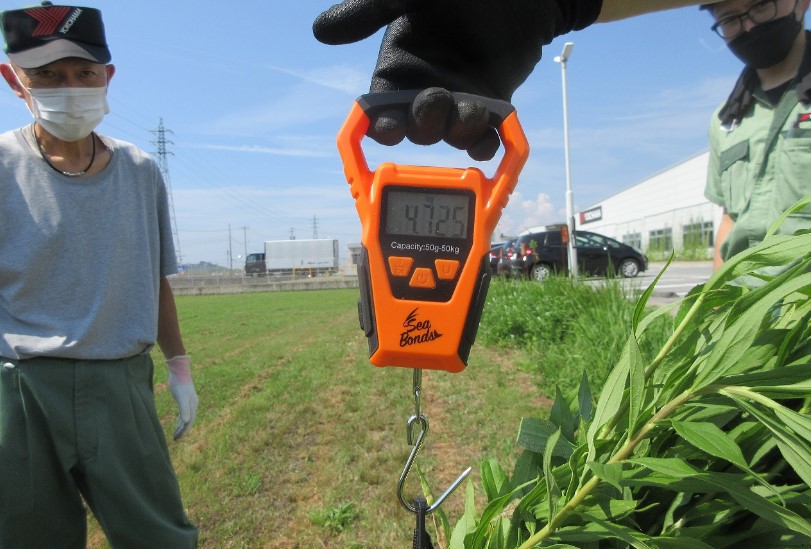
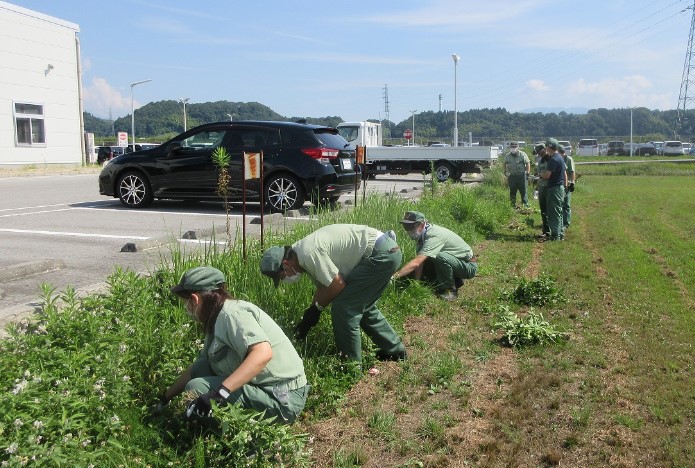
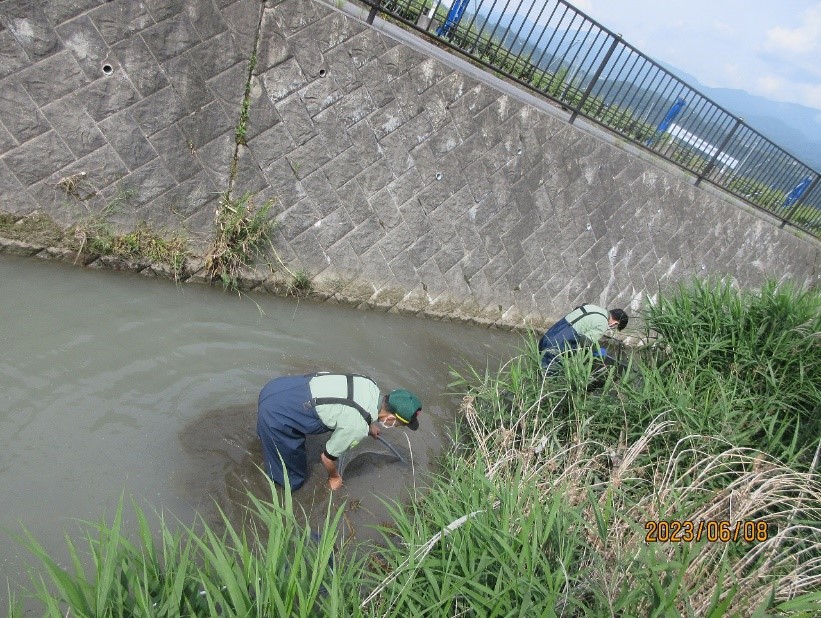
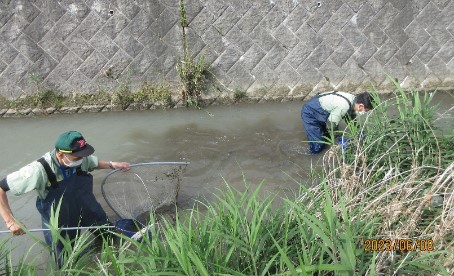
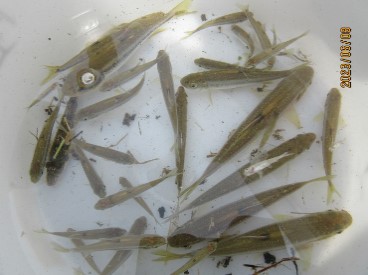
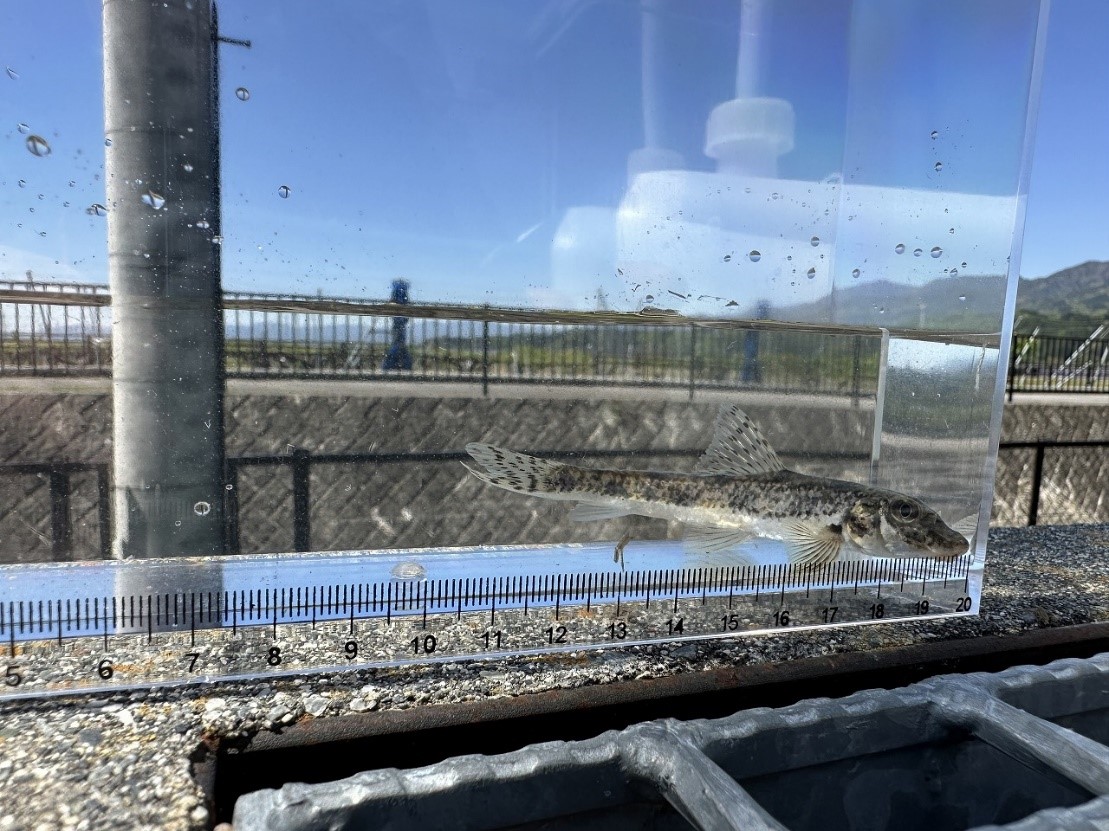
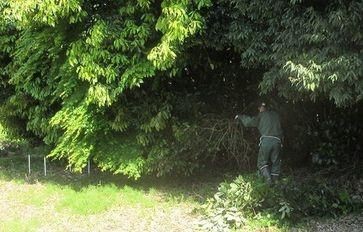
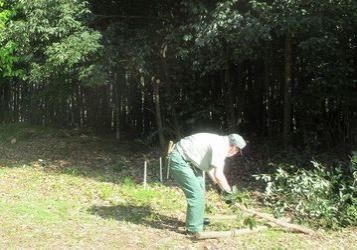
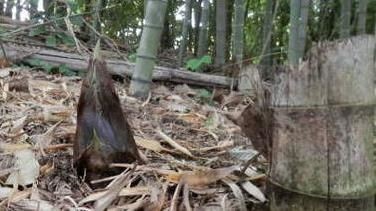

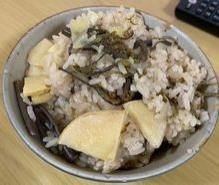
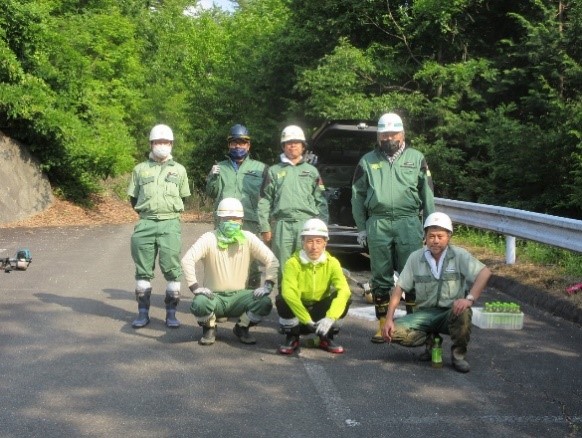
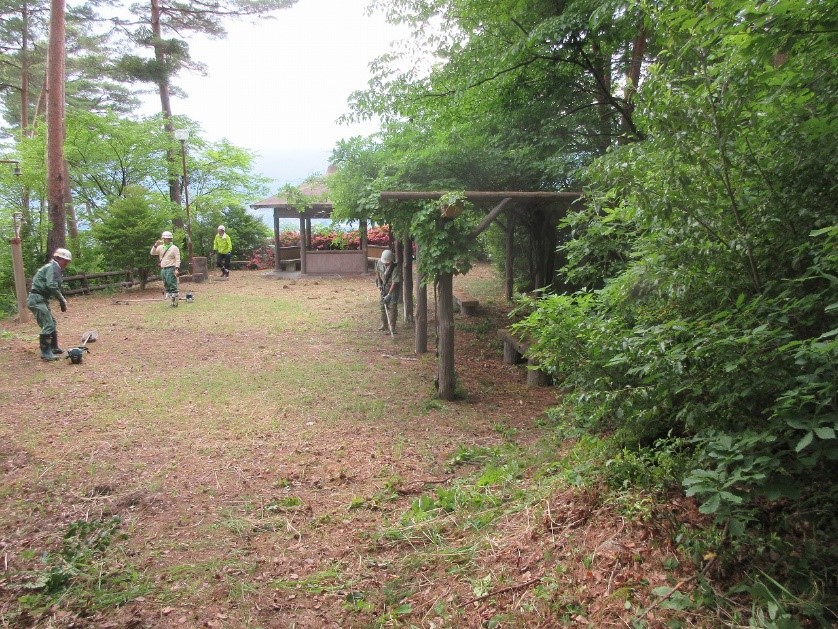
Ibaraki Plant
We started surveying birds within the plant premises in 2015, and have been continuing our survey activities. Starting in 2019, we have newly organized the project "Survey on the Living Environment of Butastur indicus (grey-faced buzzards)" to survey the vegetation and small animals (amphibians and reptiles) in the plant, focusing on grey-faced buzzards, which are registered as a near threatened species in Ibaraki Prefecture, as one of the indicators for environmental conservation. In 2020, we installed a perch for grey-faced buzzards in the plant, and confirmed it has been seen being used by those birds several times. We have also watched them flying over the plant.
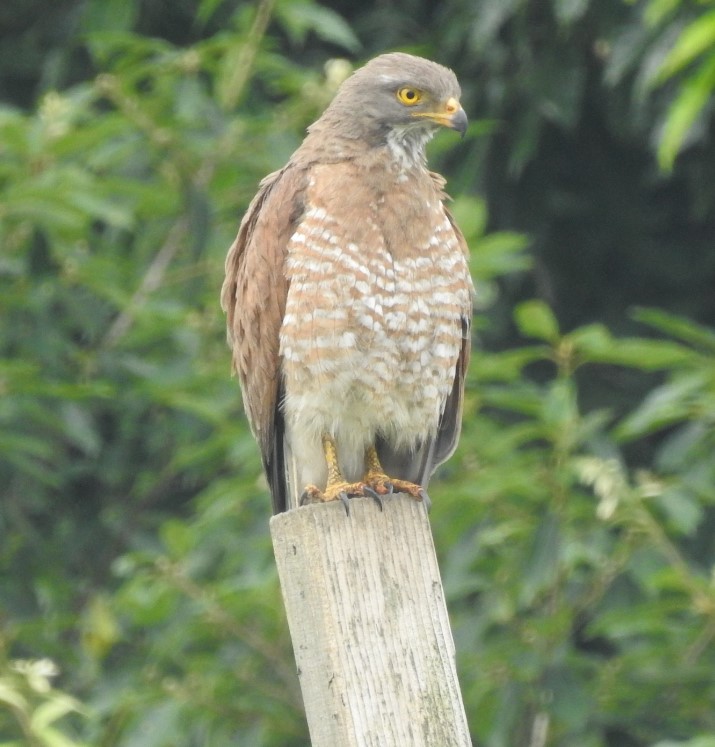
Grey-faced Buzzard using a perch installed on the factory premises
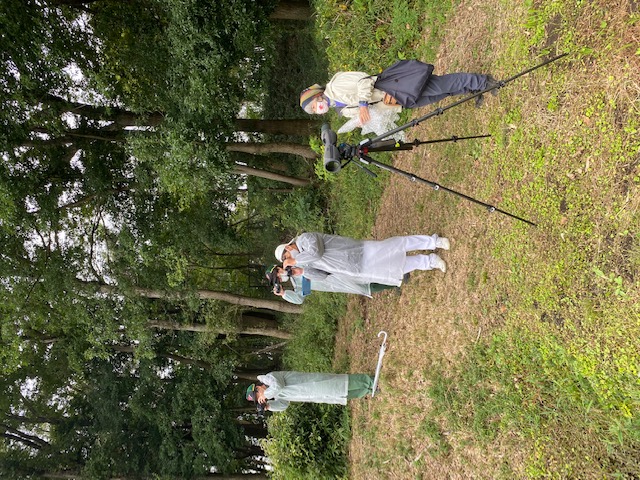
Wild bird observation within the factory premises
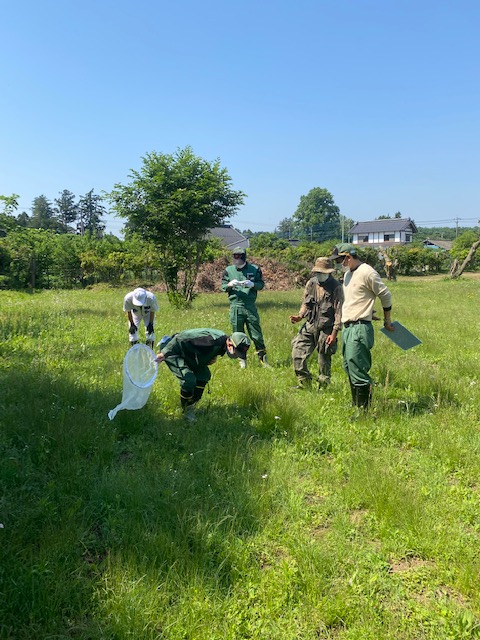
Small animal survey on the factory premises (survey on the growth environment of Grey-faced Buzzard)
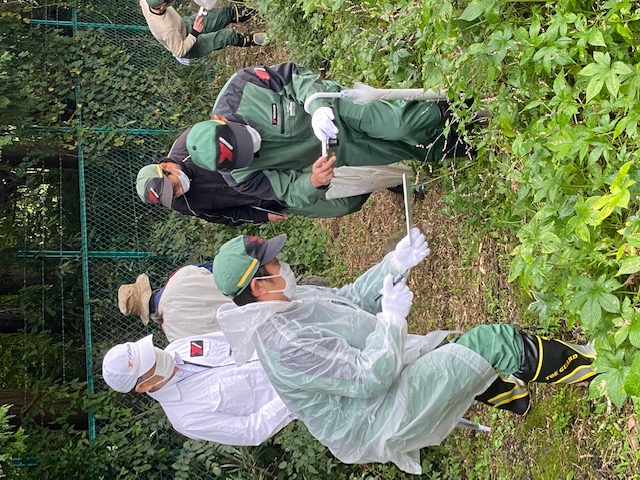
Small animal survey on the factory premises (survey on the growth environment of Grey-faced Buzzard)
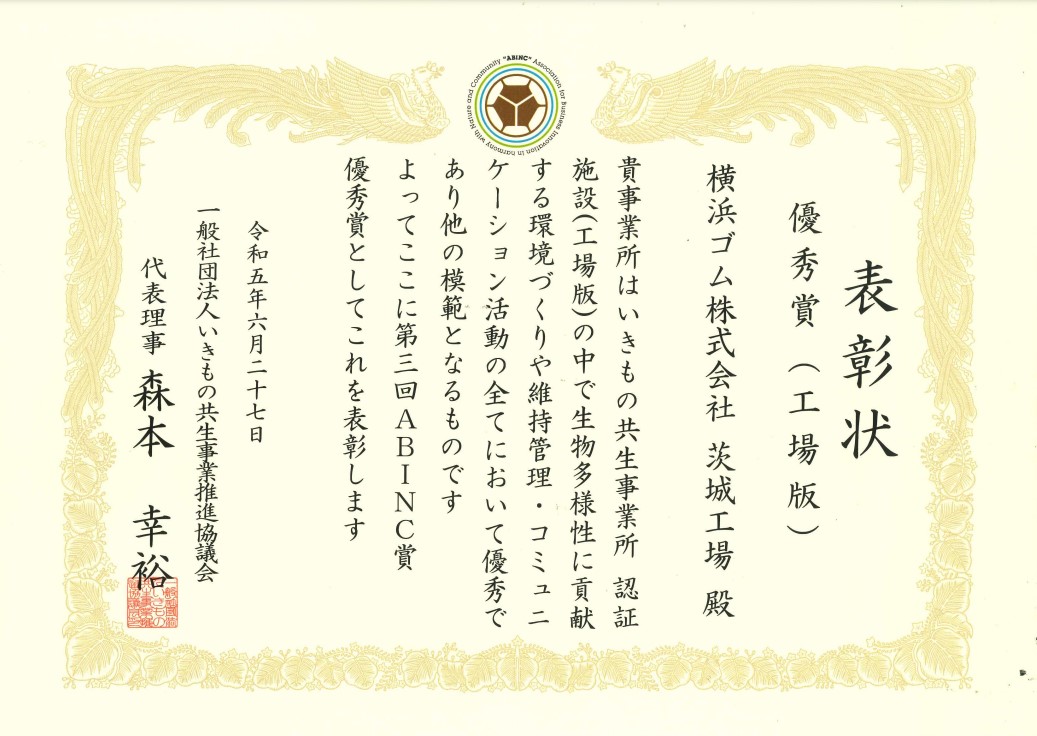
ABINC Award for Excellence Award (Certificate)
Yokohama Tire Retread Co., Ltd. Hokkaido Plant (YTRH)
To preserve this precious place, we started with the "understanding of Lake Utonai." We started learning about the origins of Lake Utonai, how the first sanctuary of Japan was established, the actual status of conservation activities, and what protection activities are required toward the future, with a ranger of the Wild Birds Society of Japan as a lecturer. We have been continuing cleanup activities around Lake Utonai and the Nature Center since 2017.
In 2022, the once-a-decade biological research by the Wild Bird Society of Japan that started 60 years ago was conducted, and YTRH participated in this event. The data obtained in the research is used for the adjustment of the water level of Lake Utonai and the maintenance of the local ecosystem.
♦Spring Cleanup Month "Zero Garbage Day" on Sunday, April 17, 2022
All the YTRH members (12 people) conducted an exhaustive cleaning of the area around Lake Utonai Sanctuary. Every year after the snow melts, they conduct this exhaustive cleaning, where a lot of trash and litters are collected. We were sad to find that this year again a lot of trash and litters including waste tires were collected. Although it was still cold, we were happy that the Lake Utonai Sanctuary was now cleaner afterward and ready for the summer. All employees will continue to work together on environmental activities and sanctuary support activities for Lake Utonai, and will also continue to engage in meaningful activities together with their families, people from affiliated companies, and the Wild Bird Society of Japan.
♦Autumn Cleanup Month "Zero Garbage Day" on Sunday, October 16, 2022
All the YTRH members (12 people) conducted an exhaustive cleaning of the area around Lake Utonai Sanctuary. They collected a lot of trash and litters in the fresh autumn air as in the last spring.
♦Removal of the invasive alien Solidago gigantea var. leiophylla (giant goldenrods) on Friday, July 15, 2021
When this activity started, the fixed-point observation site where we have conducted cleanup operations every year was occupied by Solidago gigantea , but after five years have passed, we found the number of local native Artemisia indica var. maximowiczii (felon herbs) and Spiraea salicifolia (brideworts) are growing. Therefore, we started conducting the cleanup operations in another place too. We hope to see more native plants in the new place as well.
♦Lake Utonai Vegetation Survey on Wednesday, August 24, and Thursday, August 25, 2022
Since 1962, the Wild Bird Society of Japan and researchers have taken a lead in conducting vegetation surveys at and around Lake Utonai. They have conducted the survey every 10 years, and this was the 7th survey with the year 2022 marking 60th anniversary. Responding to a request from the Wild Bird Society of Japan for support, two employees of YTRC joined the survey. Since the data obtained from the survey constitutes objective data indicating aridification (reduction in the area of the lake), it will serve as an important data for the long-term conservation of Lake Utonai. We have heard that our data is now being used by the authorities to adjust the water level of Lake Utonai. The survey was a really tough one, in which we bogged to our waists in marsh in an area where normally we are not allowed to enter and waded through bushes, but it still was a very valuable experience.
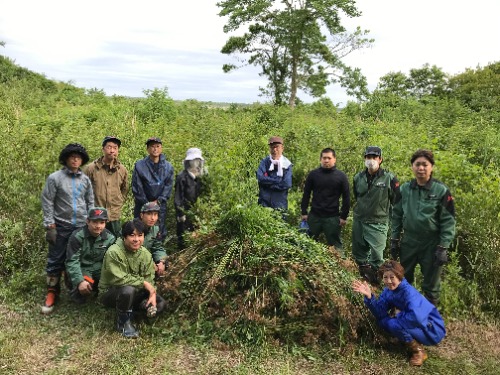
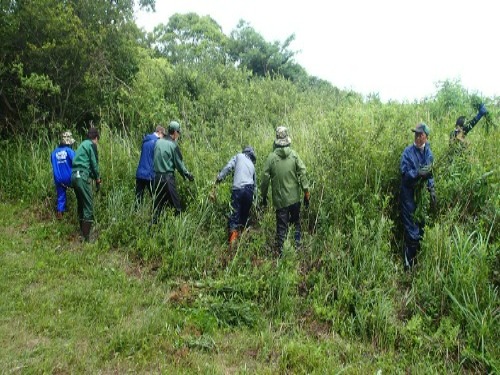
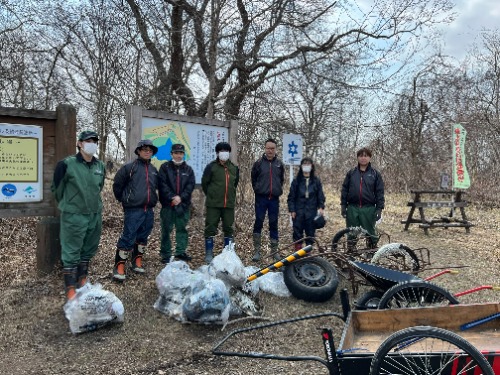
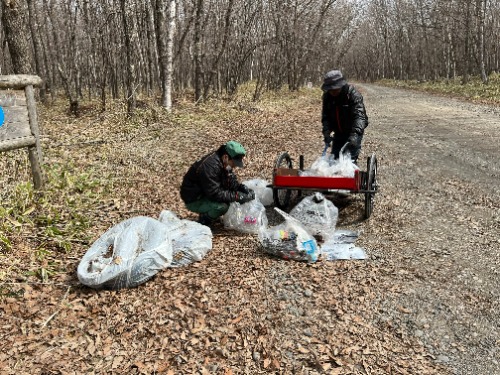
Yokohama Tire Retread Co., Ltd. Saitama Plant (YTRS)
In April 2015, a part of the YTRS biodiversity activity area was designated as the Saitama Green Trust Conservation Area No. 14. The Saitama Green Trust is an initiative to preserve the outstanding natural and historical environment of Saitama Prefecture by converting an area with such environment into a public land through the cooperation with local residents, companies, and organizations in order to preserve the local environment for future generations.
In July 2023, the "Musashino fallen leaf-derived compost farming practice" was recognized as one of the Globally Important Agricultural Heritage Systems by the Food and Agriculture Organization of the United Nations(FAO). The Globally Important Agricultural Heritage System recognizes areas where traditional and globally important farming, forestry, and fishing are practiced. In each of the recognized areas, traditional farming, forestry, or fishing that has been passed down for generations is still being practiced while adapting to changes in society and environment. Local culture, landscapes and seascapes that have been nurtured are closely associated with such practices, along with a rich biodiversity formed by the agricultural organisms.
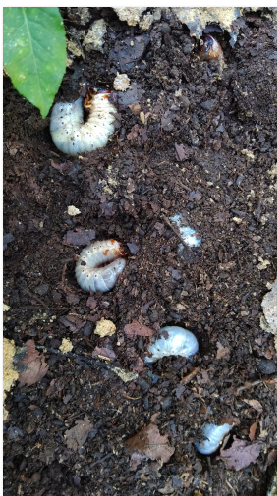
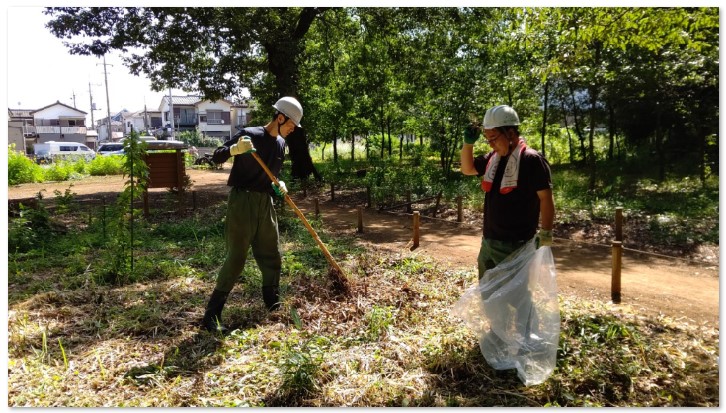
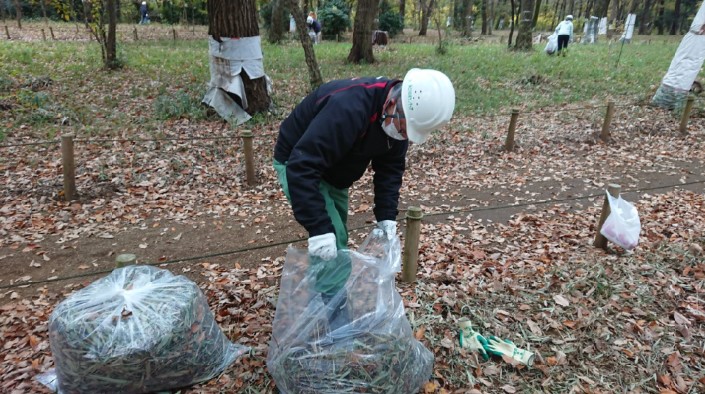
Yokohama Tire Retread Co., Ltd. Nagoya Plant (YTRN)
This NPO supported by the environment division and the municipal board of education of Miyoshino City provides opportunities to provide environmental education to local elementary school students, where the public and private sectors can work together. With these activities having been featured in local public relations magazines, we are confident that they are being appreciated and established as a valuable nature experience program for the local people. In 2023, we are planning to hold a commemorative event to celebrate our 10th anniversary, in addition to the rice planting experience event. All employees of Nagoya Plant will actively take part in the event while doing all the preparatory and background work as part of their contribution to the local community.
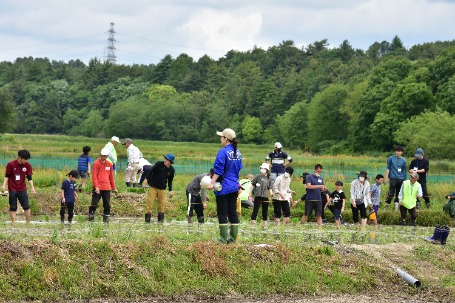
Yokohama Tire Manufacturing (Thailand) Co., Ltd. (YTMT)
In FY2022, these activities were canceled due to the COVID-19 pandemic. On July 25, 2023, YTMT sent environment officer cooperated with CSR officer of Amata City IEAT for give biodiversity education to student primary 5 of Nikhom9 primary school total 31 persons at school. The student enjoined our activity and get more knowledge about biodiversity and environmental mind.
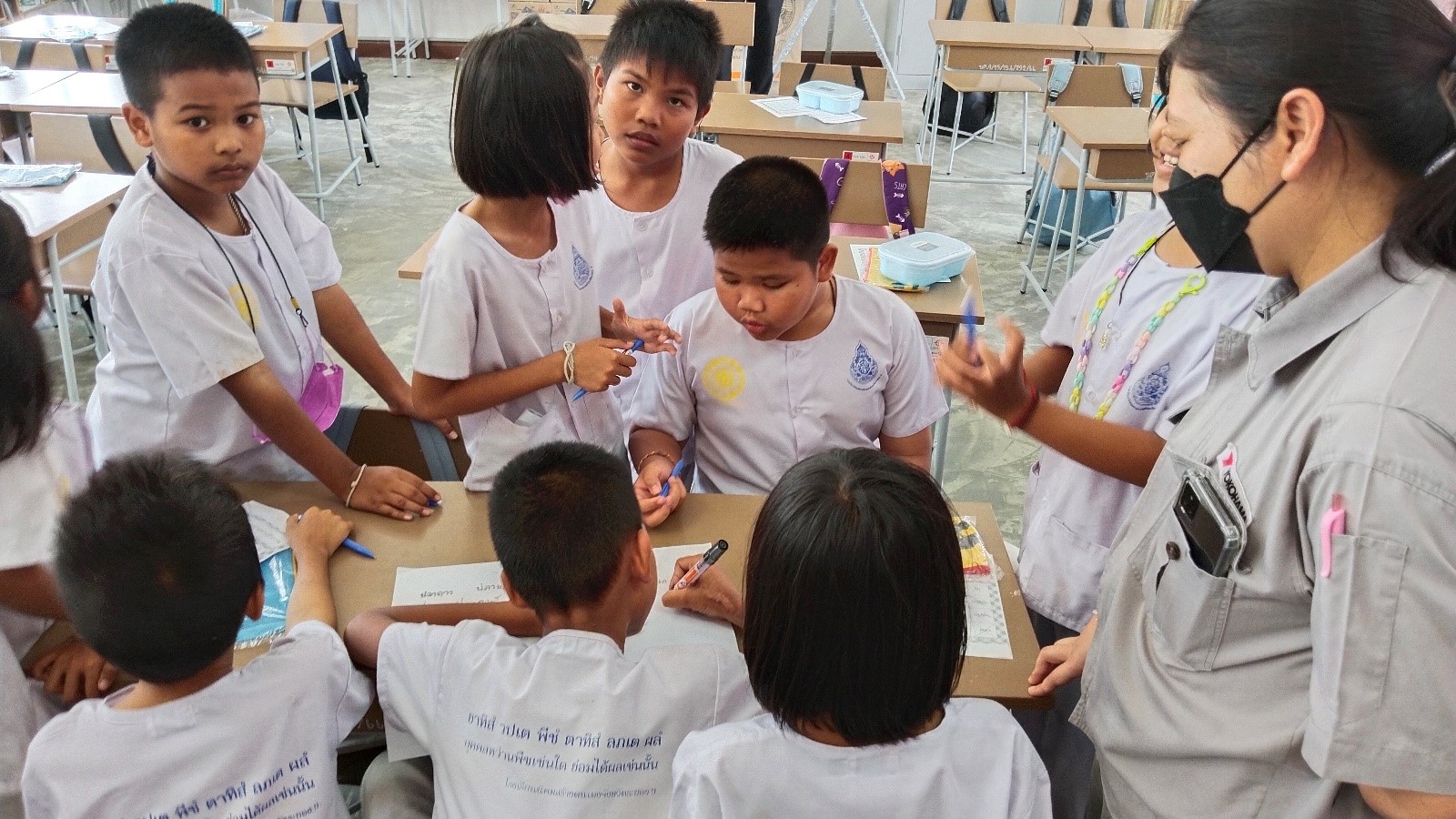
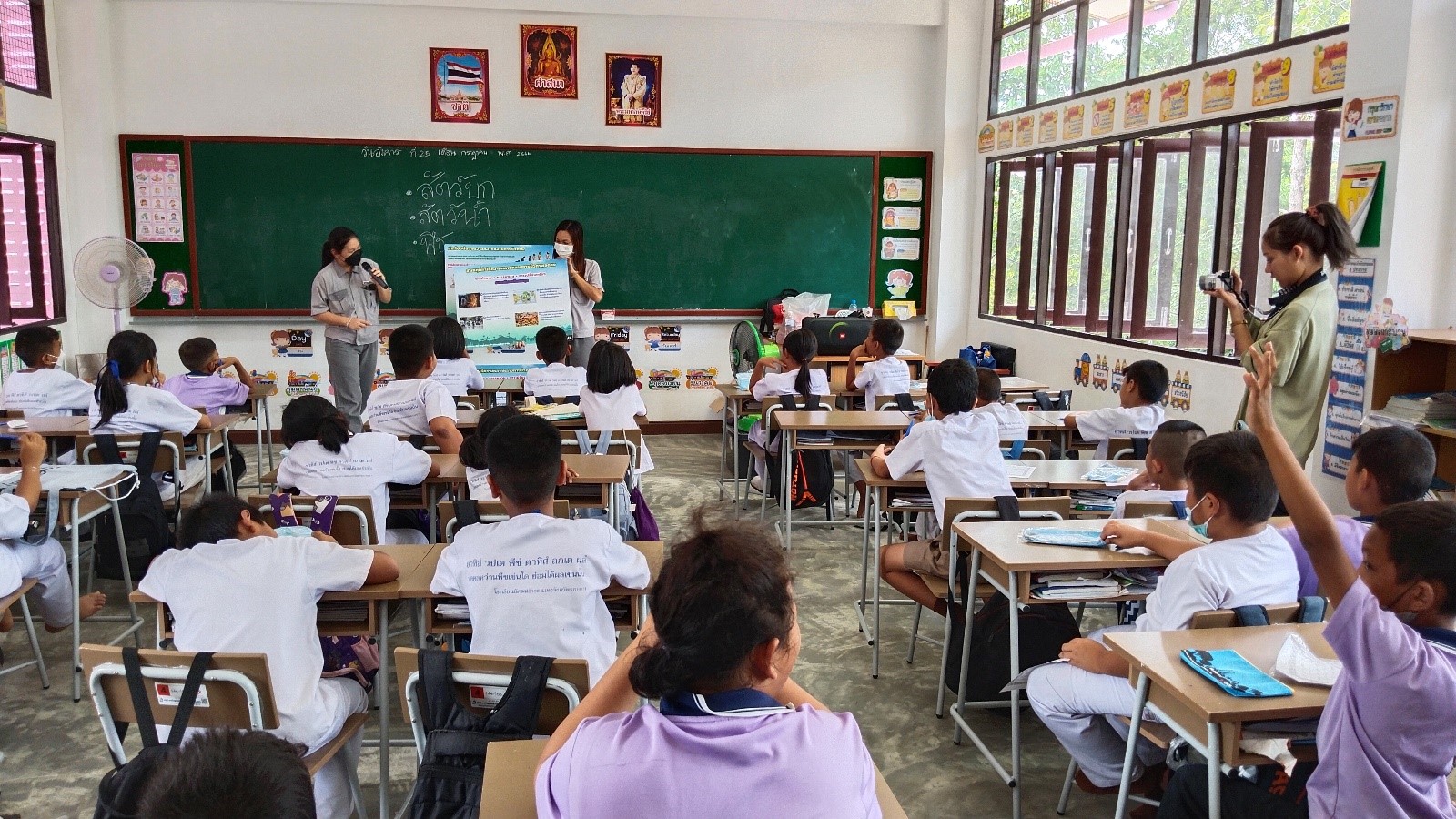
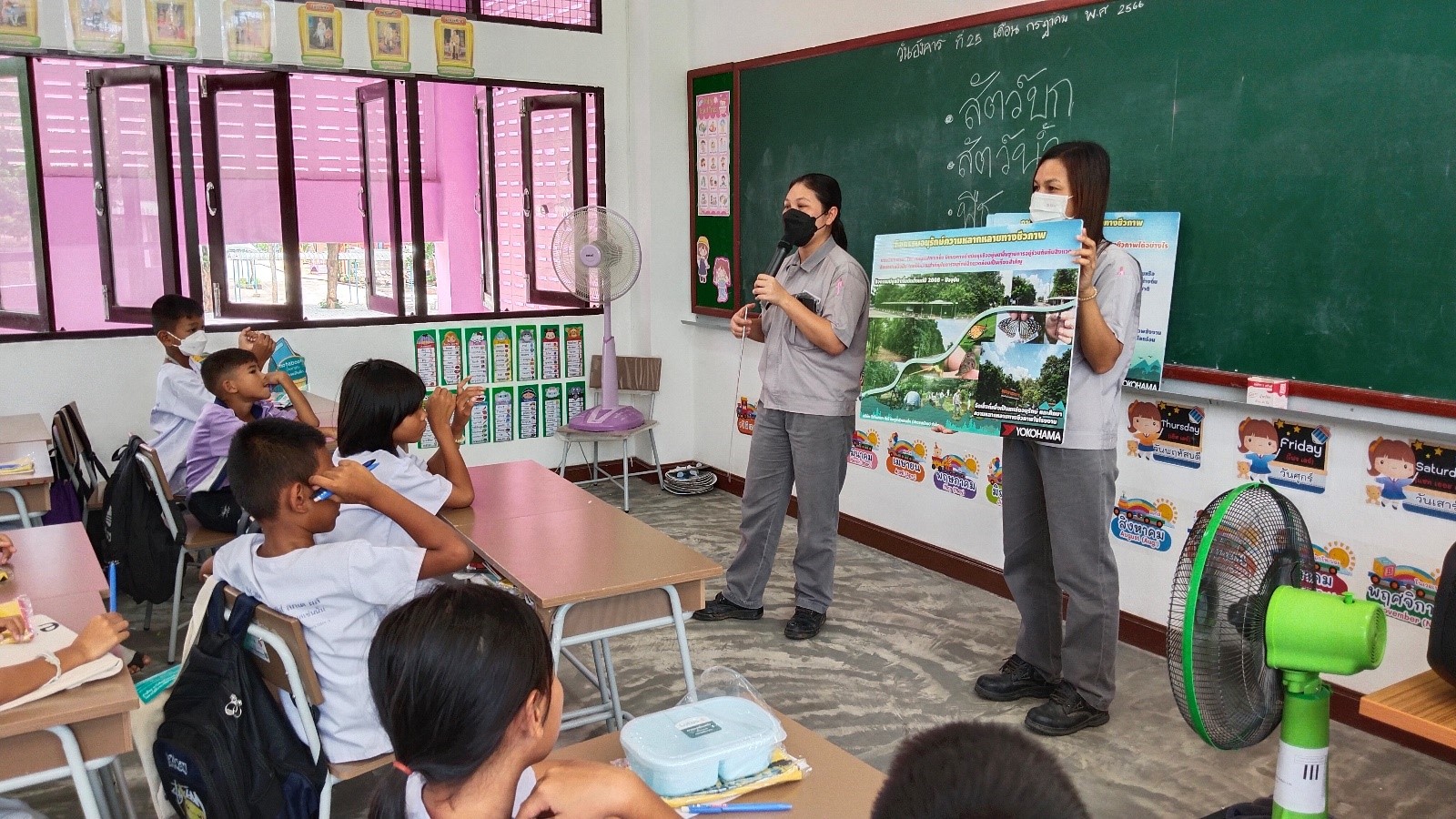
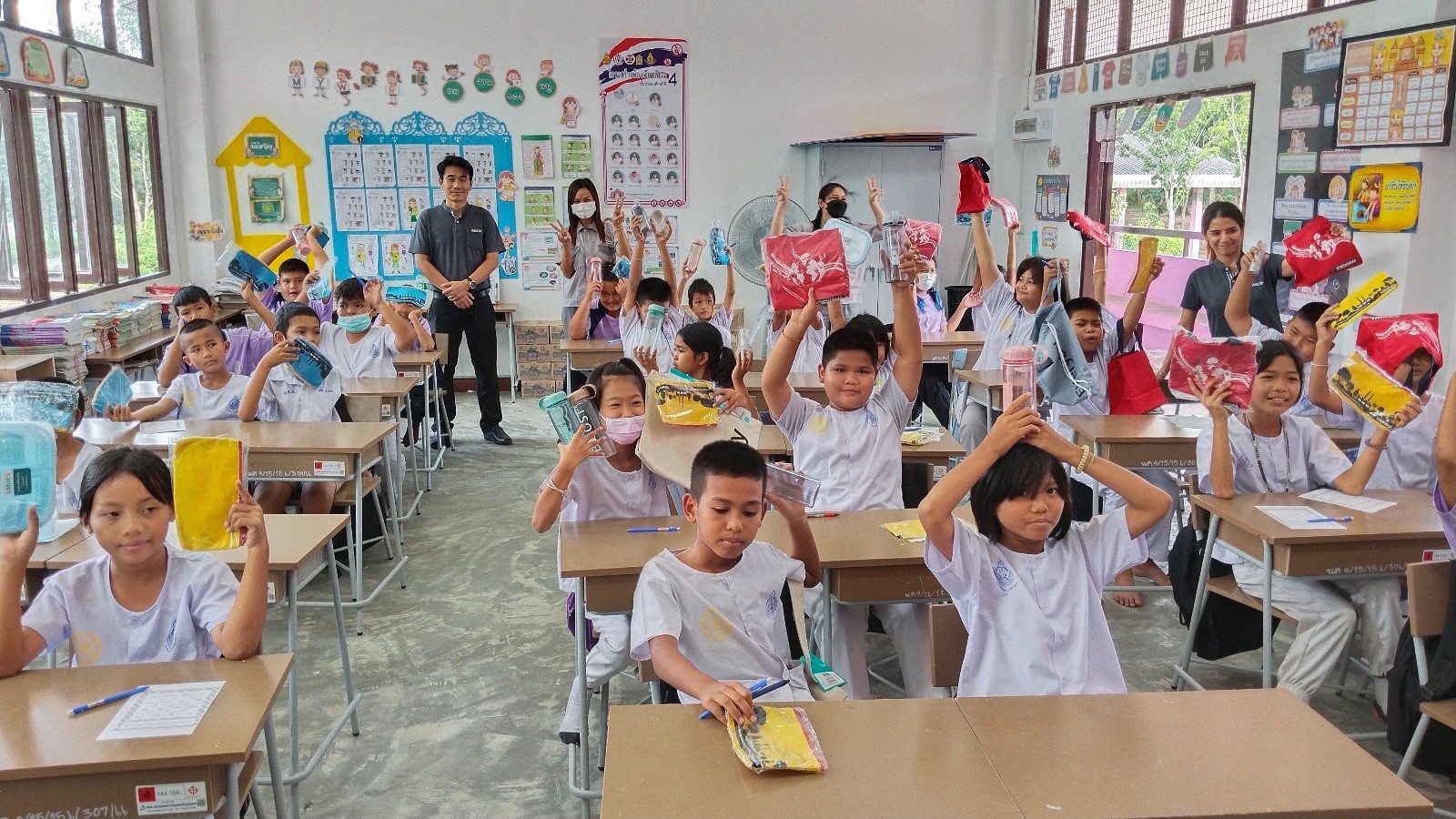
Y.T. Rubber Co. Ltd. (YTRC)
Although a lot of water is required for washing and transportation in the natural rubber manufacturing process, YTRC has a 100% water recycling system which has been active ever since the plant started operating, thus being a model of effective water use. Sediments from water used in the factory are applied to the ground to make nutrient-rich soil, which works well to create a planting mound or to grow tree saplings. We maintain the quality of factory water at the same level of the water in a nearby river through efficient use of a cleansing basin and also careful water quality checks and improvement.
YTRC has a flood-control basin on its premises where an undisturbed natural environment is maintained. We have been monitoring the fish habitat and water quality in the pond on a monthly basis since November 2014. When the water level rises during the rainy season, the water in the nearby Tapi River often flows into the flood-control basin, where more than 20 species of fish were found to be flourishing in a recent survey. In the forest surrounding this flood-control basin and the area where the trees planted as part of the Forever Forest program are growing, more than 20 species of birds have been observed in the past, and in the evenings, the sound of lively birdsong can be heard from trees. In the forest, there are a lot of palm trees that we carefully maintain by working with people in the community since the plant started operating. These people enjoy collecting the palm fruits and taking them home every month.
In addition to actively taking part in regional events and making donations, we will continue to carry out our activities with a consciousness of ourselves as a "community-minded company." YTRC will continue to maintain the environment surrounding flood-control basin and trees in cooperation with people in the community, and carry out our activities as a "community-contributing company" appreciated by the local people,
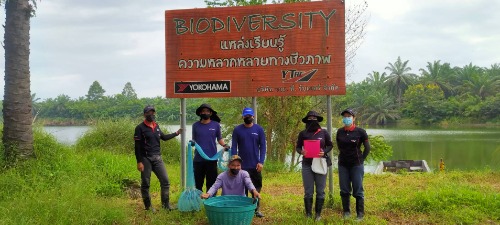
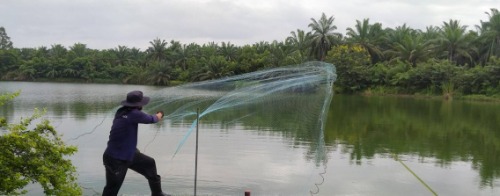
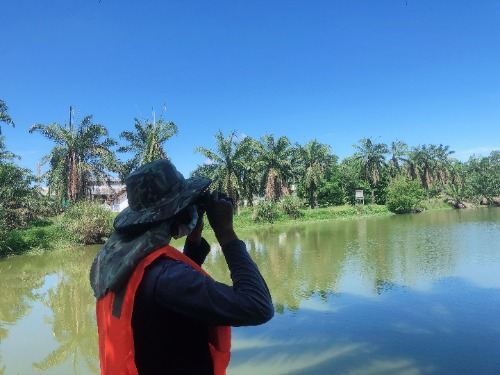
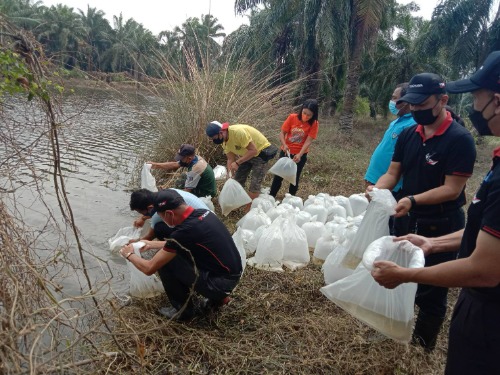
Hangzhou Yokohama Tire Co., Ltd. (CHZY)
As part of the government's environmental protection program, CHZY has been entrusted with the management of a plot of land (area: approximately 2,000m2) in the vicinity of the CHZY site as a "Yokohama Preservation Forest." Since 2013, we have conducted tree-planting activities on Arbor Day in March every year. Even though we were not able to carry out tree planting due to the COVID-19 pandemic in FY2021, we have planted a total of 150 trees to date.
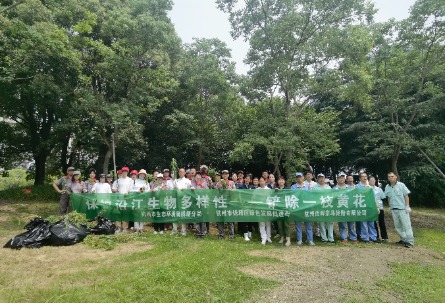
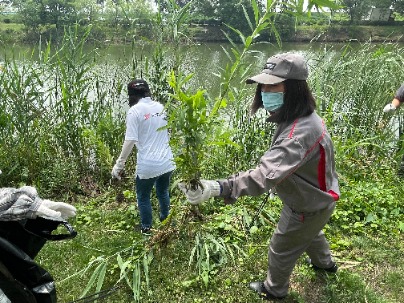
Yokohama Tire Philippines, Inc. (YTPI)
During the celebration of the Environment Month, YTPI held a tree planting activity on its grounds with the participation of the Top Officers headed by president Atsushi Funayama and the YTPI employees volunteers. A total of 26 Ilang-ilang seedlings were planted during the activity.
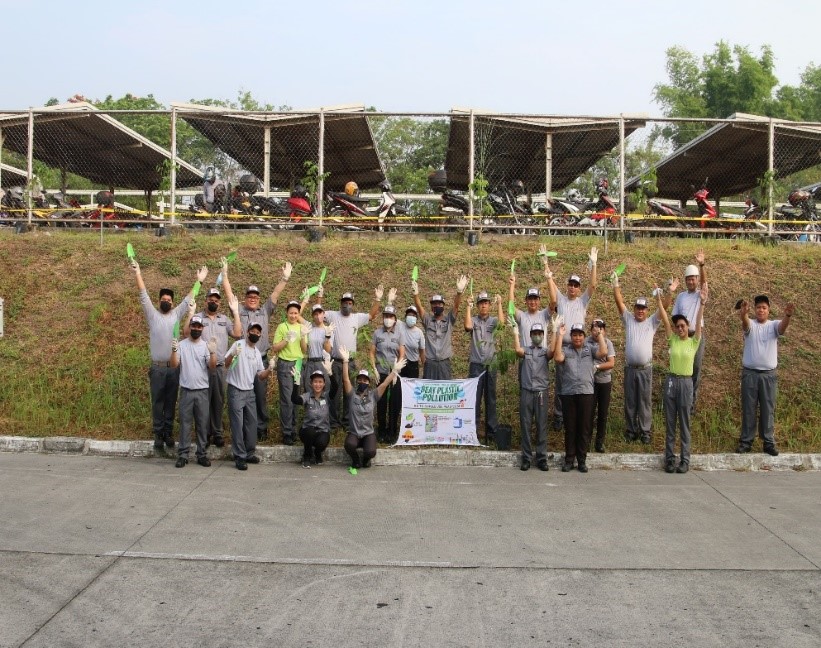
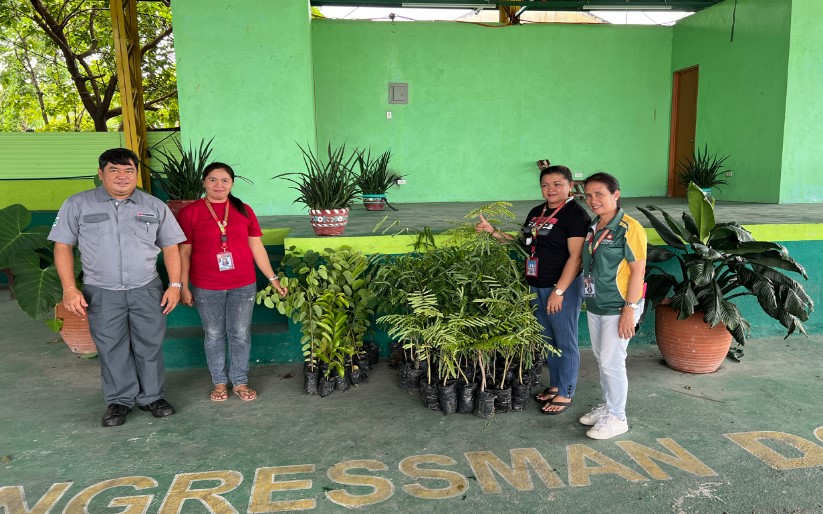
As to this date, several departments have embraced this initiative, successfully cultivating, and distributing their harvests. They also expanded from vegetable and fruit crops to flower-bearing plants like sunflowers. Moreover, the program has evolved into "Gulay ay Buhay sa YTPI," extending its reach by adopting school vegetable gardens, providing necessary supplies, and organizing the harvest for cafeteria concessions as a source of fresh vegetables.
To date, YTPI has partnered to four schools namely around the community – San Joaquin Elementary School (SJES), Mauaque Resettlement High school (MRHS), Mauaque Resettlement Elementary School (MRES), and San Vincent and Elementary School (SVES). The program intends to include more schools in the future to further enhance community partnership.
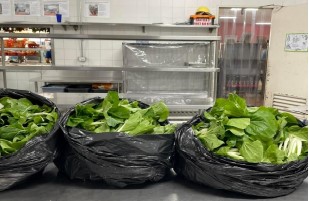
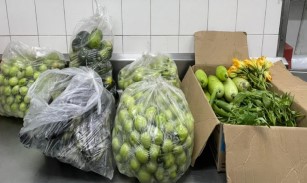
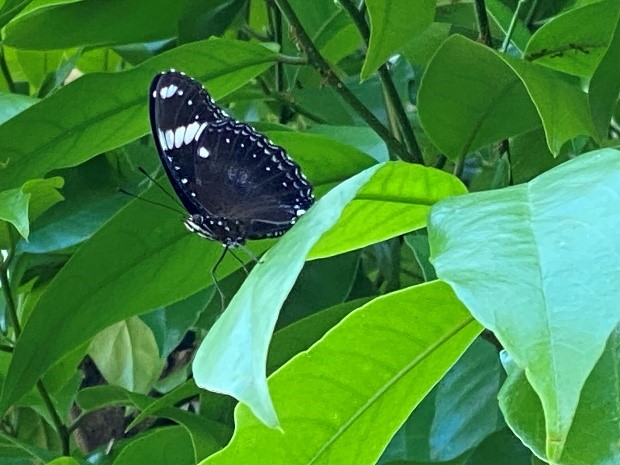
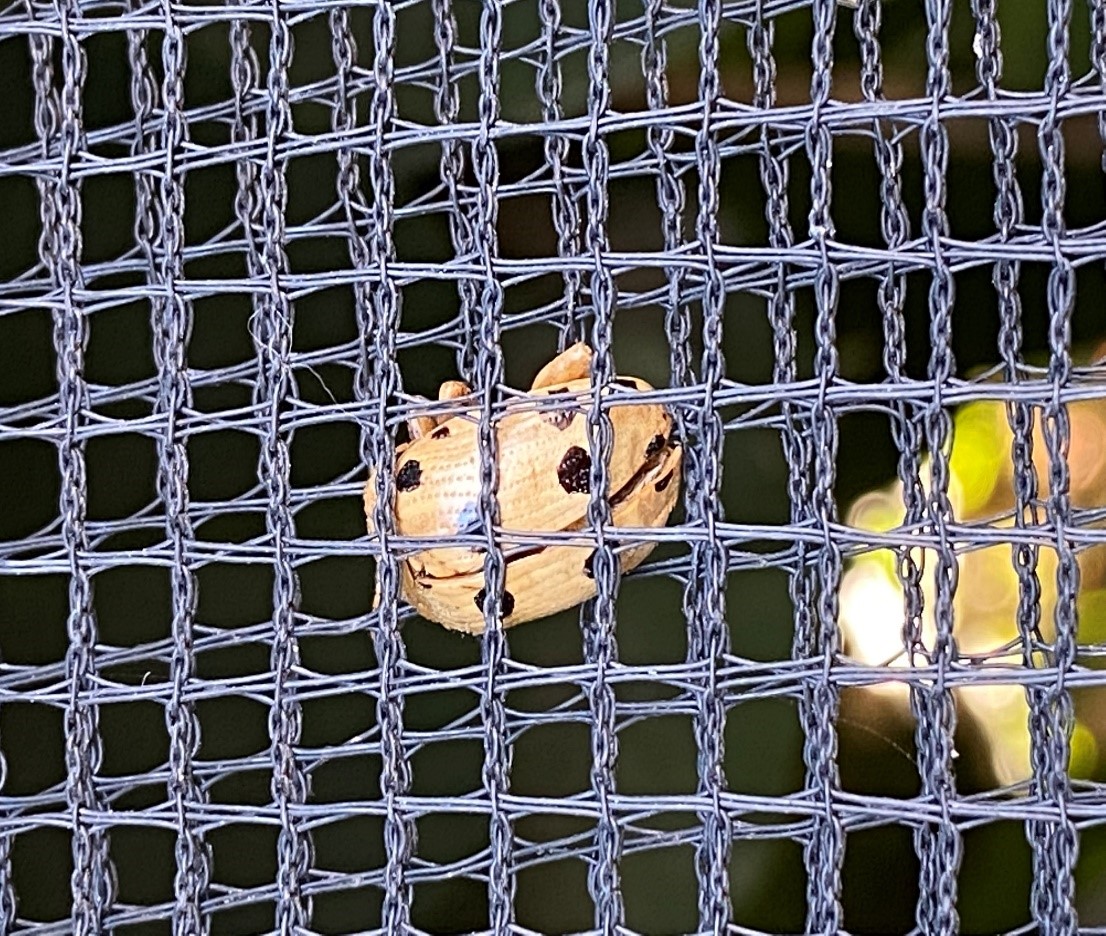
Yokohama Tire Manufacturing Virginia(YTMV)
Since 2015, YTMV has set up nest boxes to protect breeding Sialia sialis (Eastern bluebirds), and since then, all employees watch over the baby birds as they grow.
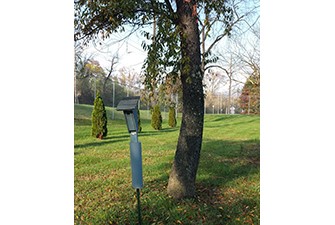
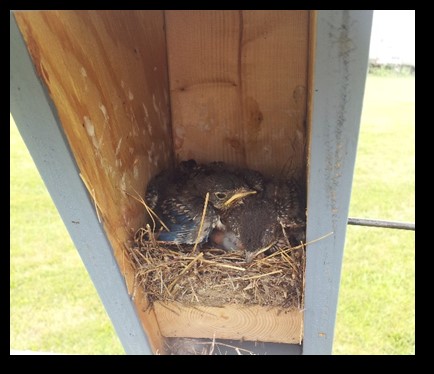
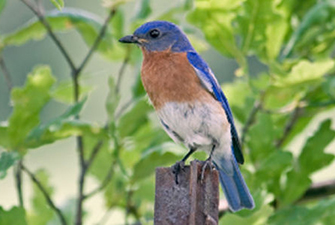
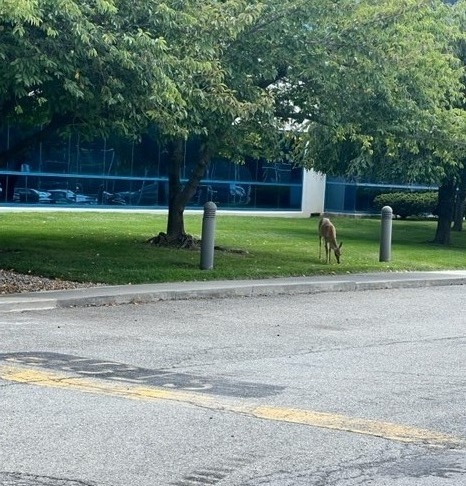
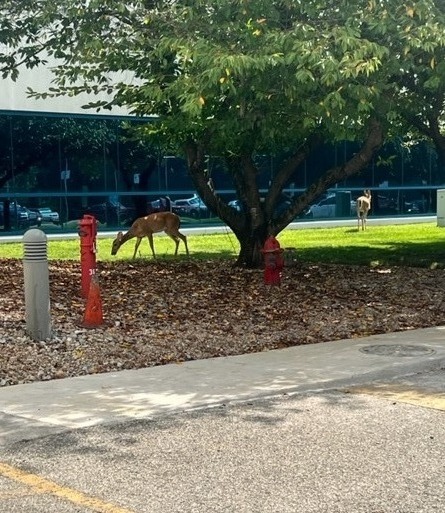
Suzhou Yokohama Tire Co., Ltd (CSZY)
On May 27 2022, 23 new employees conducted a survey on biodiversity within the factory. On May 27 2023, CSZY also held its 15th biodiversity survey activity event jointly with the New District Ecological Environment Bureau and the New District Environmental Protection Council. Children and students from neighboring kindergartens, elementary schools and junior high schools and their parents and teachers joined the events with CSZY employees and helped with the survey activities. In the survey, participants counted the number of insects, plants and birds within the premises to understand how they live, and measures the growing conditions of trees in the CSZY's Forever Forest. The survey also revealed that the number of egrets has increased. The event helped the local residents to understand what CSZY is doing to protect indigenous creatures and conserve the local environment. Biodiversity survey activities enable us to understand the status of the biological environment within the plant premises, and also help to preserve the local ecosystem and harmonize with the local community while conducting business activities at the plant.
In the CSZY activities, they have observed birds such as sparrows and egrets, plants such as Triadica sebiferum (Chinese tallow trees), Malus halliana (hall's crabapples), Ligustrum obtusifolium (border privets), Taraxacum (dandelions), Ipomoea nil (morning glories), and Bellis perennis (common daisies), insects such as Apis (honey bees) and butterflies, and earthworms. At the same time with observing these creatures, they also collect tree seed nuts to grow saplings for our Forever Forest Program. At the survey event, in addition to observing the living creatures, the CSZY teams confirmed the healthy growth of their Forever Forest, which gave them a valuable opportunity to deepen their understanding of how its growth is positively impacting the local ecosystem.
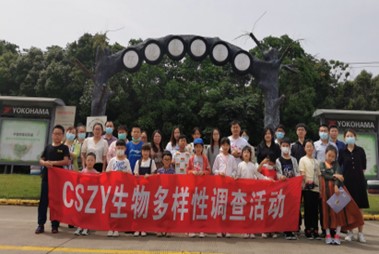
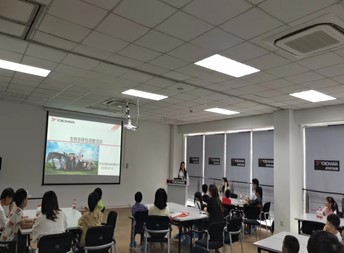
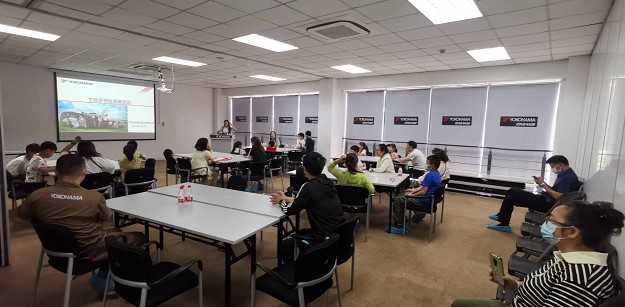
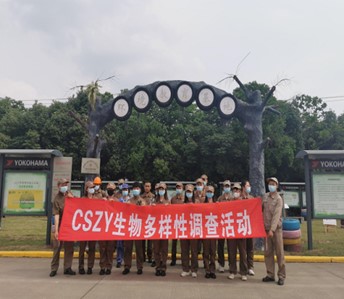
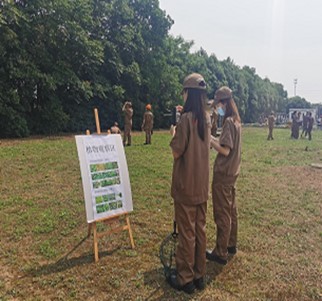
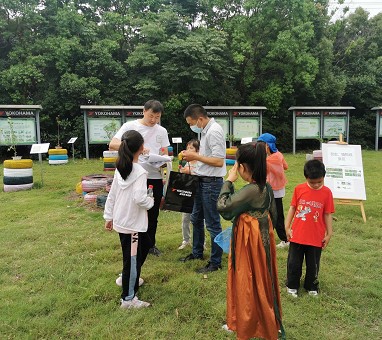
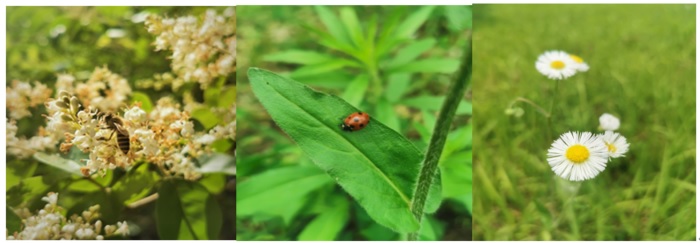
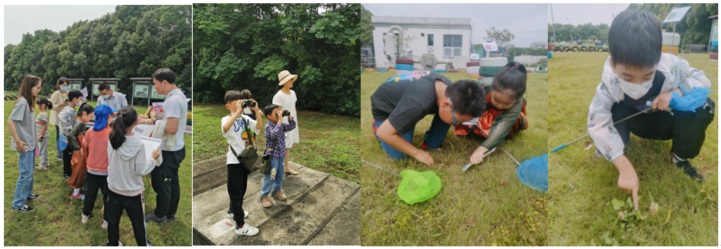
Yokohama Tyre Vietnam Inc.(YTVI)
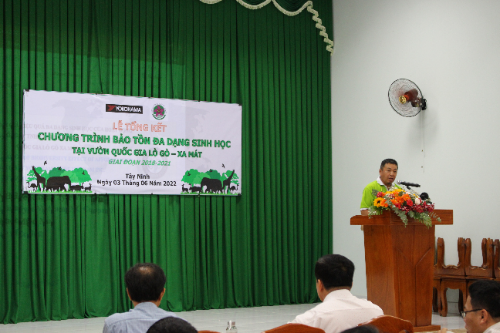
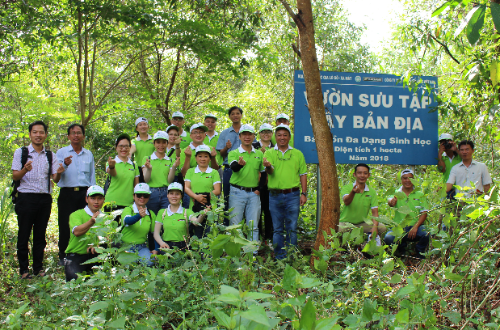
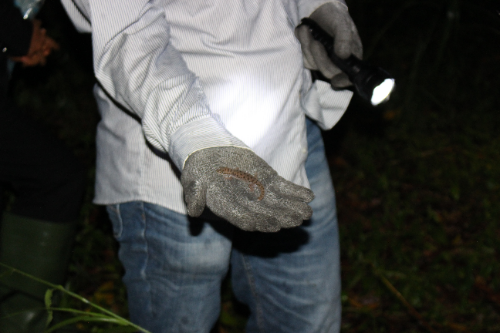
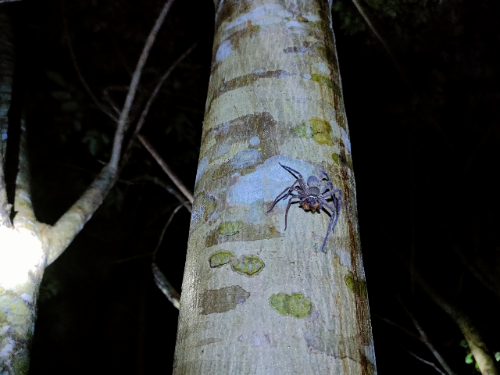
Future challenges
In order to make meaningful efforts in line with the discussions within these frameworks and the wider penetration of their concept across the world, we will define our priority biodiversity commitments as part of the overall business activities of the Yokohama Rubber Group, and promote activities to pursue these commitments and actively share information to deepen the understanding of our employees and stakeholders.


